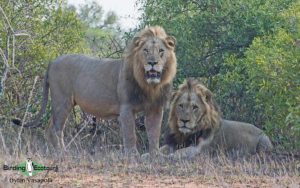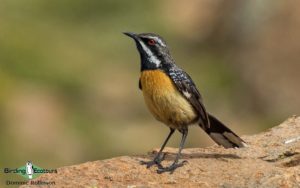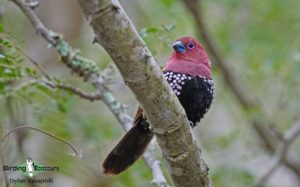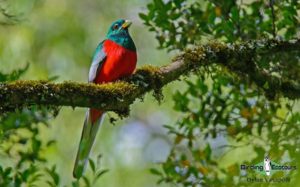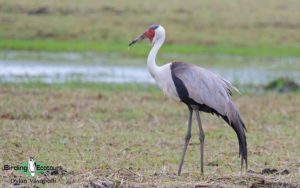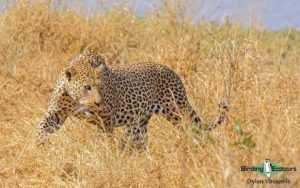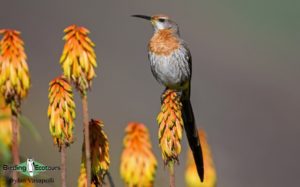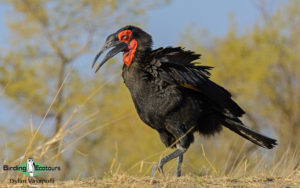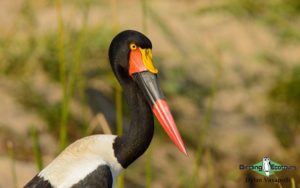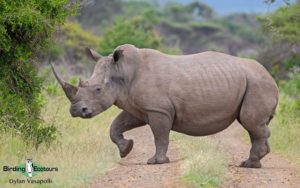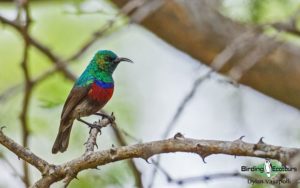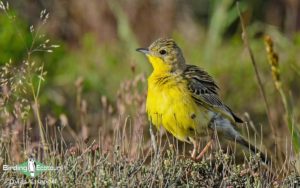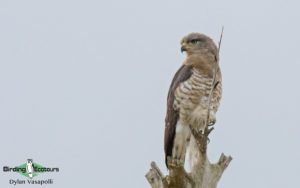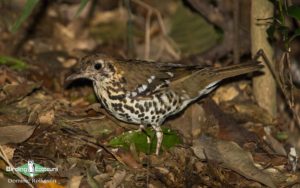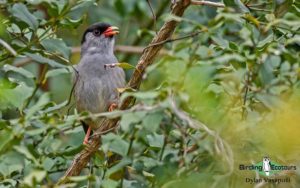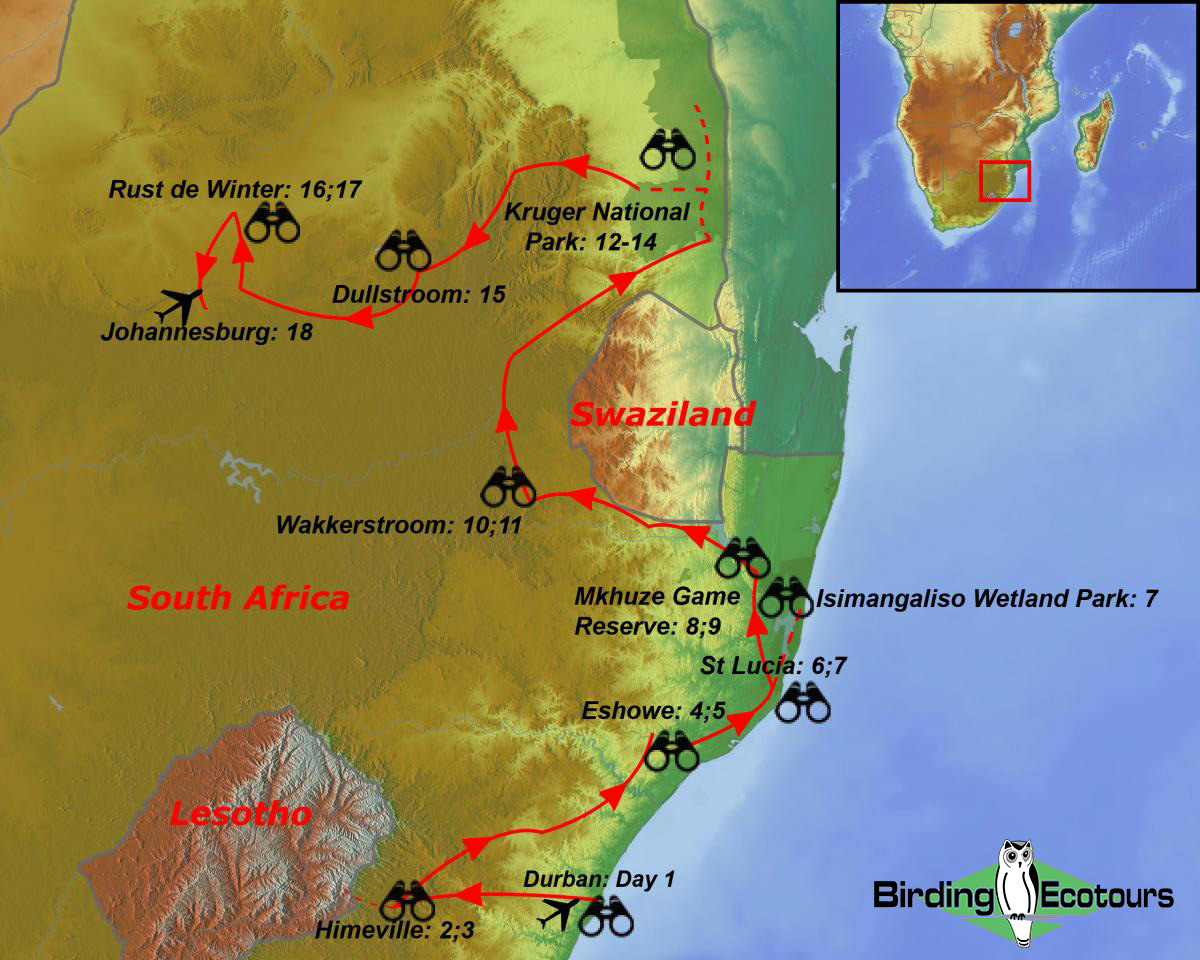Subtropical South Africa Birding Tour: Comprehensive Eastern South Africa
Go to: South Africa Birding Tours | Birding Tours in Africa | All our birding tours
Subtropical South Africa Birding Tour: Comprehensive Eastern South Africa
October 2025/2026
This is a premium tour with open safari vehicles in Kruger and enough time to stop for mammals while accumulating a large bird list
This subtropical (eastern) South Africa birding tour provides a representative sample of the very best that African birding can offer. Large numbers of species will be seen (the typical bird list for this adventure is in the range of 400 – 450 species for our October departures when migrants are present). Among these many birds, we encounter a lot of South African endemics such as the numerous localized denizens of the scenically spectacular Drakensberg Escarpment (the imposing “Barrier of Spears” as locals call it). Apart from yielding hundreds of bird species, this dream African experience also provides the possibility of seeing Lion, Cheetah, Leopard, African Elephant, White and Black Rhinoceros, Hippopotamus, Giraffe, Burchell’s Zebra, multiple antelope species, Nile Crocodile, and many other large (and small) animal species, with breathtaking scenery as a backdrop. We also often get feedback that the accommodation on this tour is great and indeed South Africa has an unsurpassed infrastructure of brilliant value B&Bs/lodges as well as good roads, compared to anywhere else in Africa.
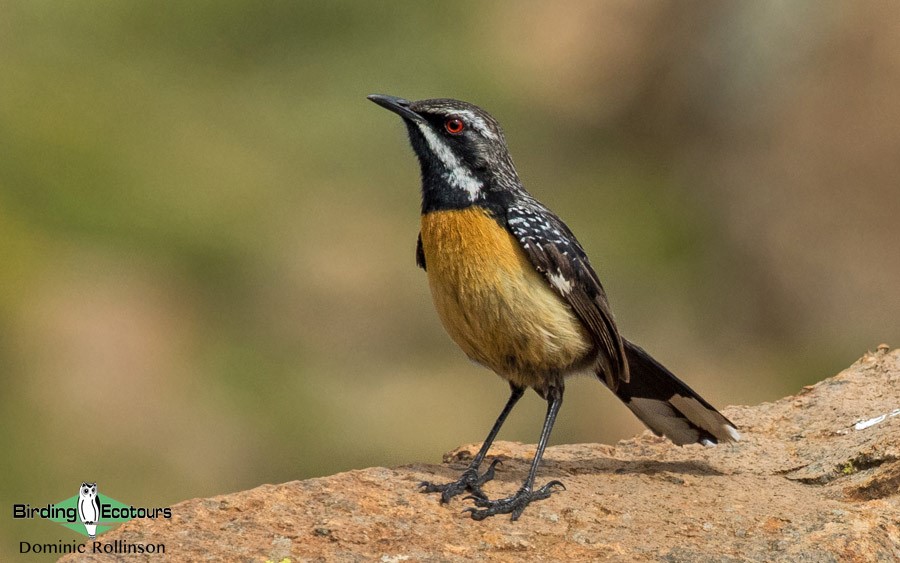
We start this birding safari with an arrival in Durban on the east coast of South Africa, bounded by the warm Indian Ocean. Durban must be one of the “birdiest” cities on earth, and here we spend time looking for subtropical coastal species. We then head inland to the KwaZulu-Natal midlands and the foothills of the spectacular Drakensberg area of the Great Escarpment, where temperate forest and high-altitude grassland birds abound. The rare Cape Parrot is one of the targets (which, interestingly, cannot be found on our Cape birding tour despite its name), as are the beautiful Green Twinspot, two dapper ground thrush species (Spotted and Orange Ground Thrushes), the dazzling Narina Trogon, the impressively beautiful Green Twinspot, and, last but not least, the Vulnerable, declining Blue Swallow (what a truly spectacular-looking hirundine!). We then ascend the heights of the Drakensberg into Lesotho via Sani Pass, an amazing road that gives access from the base of the escarpment right up to the high plateau at 10,000 feet (over 3,000 meters), with different endemics appearing as elevation increases – near the base are birds such as Bush Blackcap, then as one ascends Gurney’s Sugarbird, Ground Woodpecker, Sentinel Rock Thrush, and the shining, metallic Malachite Sunbird appear, followed eventually by high-plateau species including Drakensberg Rockjumper, Drakensberg Siskin, and Bearded Vulture (which we often see across the border in the tiny kingdom of Lesotho).

Zululand, probably the most bird-diverse corner of South Africa, is next on our agenda, and not only does it have a great many species, but there are several very localized ones, basically only occurring here and in southern Mozambique – e.g. Pink-throated Twinspot, Lemon-breasted Canary and Neergaard’s Sunbird. This also is big mammal country and one of the world’s strongholds for Black and White Rhinoceros, is very good for Leopard, and also hosts a variety of mammals not likely to be seen in Kruger – including Samango Monkey, Nyala, the absolutely tiny Suni antelope, etc.
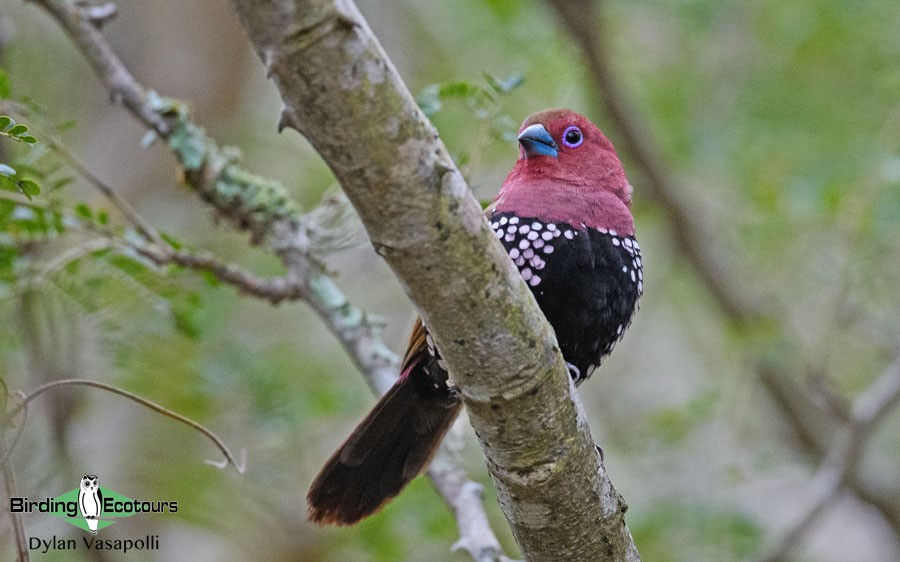
We then ascend to the legendary (among birders seeking endemics) Wakkerstroom highlands, and eventually we reach the Kruger National Park, one of the world’s greatest game parks, which is not only teaming with African megafauna but also has a brilliant bird list of over 500 species, many of them large and spectacular (e.g. a bunch of stork, raptor and owl species not to mention bustards and Secretarybird) or brightly-colored (e.g. all the barbets, bee-eaters, rollers, hoopoes and kingfishers): African birding is a feast for the eyes.
Before flying home out of Johannesburg, we sample an area which gives access to some Kalahari-type birds, meaning we usually add a disproportionally large number of species to our already large bird list right at the end of the trip – these include such beauties as the shockingly brightly-colored Crimson-breasted Shrike, the very striking Southern Pied Babbler, Violet-eared Waxbill, Black-cheeked Waxbill, Kalahari Scrub Robin, the amazingly beautiful Long-tailed Paradise Whydah, and a plethora of others.
We have specially crafted this unusually comprehensive birding tour of mega-diverse (from both a bird and mammal point of view) Eastern South Africa, allowing us sufficient time to adequately cover and explore all the key areas, without compromising on rushed visits which lack the time required to both find and enjoy the birds on offer. To further add to the experience, this tour uses open-top safari vehicles for the two full days in the Kruger National Park which ensures guests make the most of their time in the African bush. As always, we also err on the side of superior accommodation, and we therefore call this a “premium” tour yet the overall price is still reasonable mainly because South Africa is arguably the best value country on the entire continent.
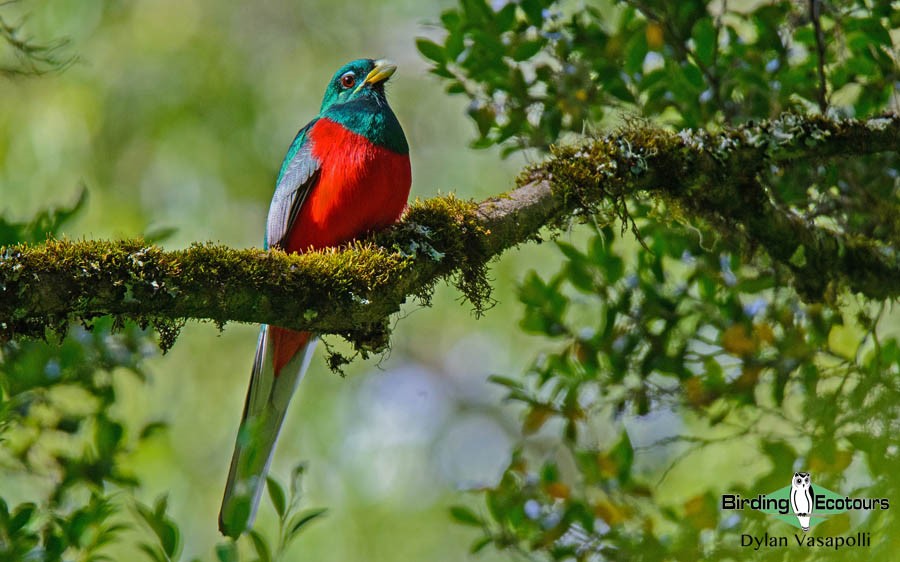
Our October subtropical South Africa tour each year can be combined with our preceding Best of Cape Town and Beyond – endemics, seabirds and more if you want to see a good proportion of South Africa’s birds (the Cape Town area is very different from eastern South Africa and complements it very nicely, with a different suite of endemics and other birds!). This trip can also be combined with our Namibia, Okavango and Victoria Falls Birding Adventure afterwards, which in turn can be combined with our Zimbabwe Birding Tour; if you combine all these trips you’ll definitely experience a stunning southern African mega tour that will leave you with an impressive bird list (not to mention mammals and other fauna and flora). While this subtropical South Africa trip is one of the best ones for seeing big and small African mammals (although we still markedly focus on birds, of course, but do build in enough time to stop for each mammal species we encounter as well), if you want more time in one of the world’s greatest game parks, then we should also mention an alternative, our Kruger National Park and Escarpment birding (and mammal) tour.
Itinerary (18 days/17 nights)
Day 1. Arrival in Durban and transfer to Pennington on the south coast
Your international flight (or local flight if you are joining us from our preceding Best of Cape Town and Beyond Birding Tour) arrives in Durban (King Shaka International Airport), and we transfer out of the city to a small coastal village. We kindly ask for your flight to arrive around midday (or we can book an extra night for you in Durban before the tour starts). For those joining both our Western Cape and Subtropical (Eastern) South Africa birding tours, the Birding Ecotours office will advise/help book you onto the exact domestic flight required to join these tours, so that the group can travel together.
Following your arrival, the group will have lunch locally, before undertaking a short transfer south of the city, to the small coastal village of Pennington. Here we are conveniently based right next door to the excellent Umdoni Park, which will give us a great introduction to the common birds of the area, while also providing us access to excellent coastal forest, where we can begin searching for some sought-after species. We will likely have the afternoon available to explore the trails at Umdoni Park, covering a mix of coastal forest and open woodland. Some of the more conspicuous species we’re likely to find include the gaudy Purple-crested Turaco and the bright Red-capped Robin-Chat, while we’re likely to come across a number of barbets, flycatchers, sunbirds (including the tiny Collared Sunbird) and weavers.
Overnight: Botha House, Pennington
Day 2. Pennington to Underberg, birding en route
We have the morning available to further explore the stunning subtropical coastal forests of Umdoni Park. As we will likely already have become acquainted with many of the more common species of the area, we can now focus on some of the more sought-after species occurring here, such as Crowned Eagle (Africa’s heaviest and most powerful eagle, which sometimes breeds in the park), the incredibly beautiful South African endemic Knysna Turaco, the equally dazzling Narina Trogon, the personality-filled Green Malkoha, the localized Brown Scrub Robin and the jewel-like Green Twinspot.
We will then spend the remainder of the day gradually heading deeper inland, ultimately arriving at our base in the Underberg district, set in the Drakensberg foothills, in the late afternoon. There are a variety of routes we can take to reach Underberg, however, our first stop will likely be for some forest birding where we target a range of localized specials. We will also be sure to dedicate some time today to finding the stunning Blue Swallow (the swallows have become rare in South Africa, and, depending on their recent whereabouts, we may only be able to try for them on Day 4). The dense temperate evergreen Ingeli or Xumeni Forests will also likely feature as a stop today, and here we will be able to sample our first patch of Afro-montane (mountain) forest. While these forests can be quiet at times, persistence and patience are well rewarded, and we stand excellent chances at finding some top specials, including the likes of Bush Blackcap, Orange Ground Thrush, White-starred Robin, Olive Bushshrike, Yellow-throated Woodland Warbler, Barratt’s Warbler, Swee Waxbill and Forest Canary, all of which are regular here. While Cape Parrots do occur here, they are scarce and best sought on Day 4 of this itinerary. The forest surrounds are not to be excluded, and host further excellent birding, with species such as Grey Crowned Crane, Red-chested Flufftail, African Yellow Warbler, Wailing Cisticola and the spectacular Long-tailed Widowbird all possible. Eventually we will arrive at our comfortable base in the Underberg region, where we will begin preparing for one of the most anticipated, and arguably best days of the trip tomorrow, as we bird the famous Sani Pass!
Overnight: Sani Valley Lodge, Himeville
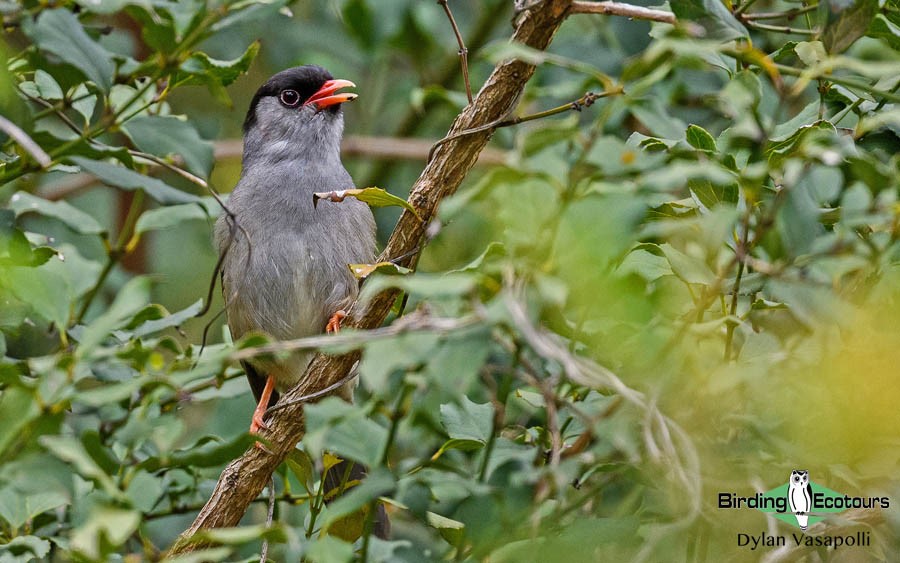
Day 3. Birding day trip up the Sani Pass and into Lesotho
This is one of the most spectacular birding adventures one can embark on. We spend a full day, taking along picnic breakfasts and lunches, ascending the Sani Pass and travelling into Lesotho (passports required), which gives amazing access to most of the Drakensberg endemics within the space of a single day. The “barrier of spears” (as the Drakensberg is known to locals) is impressive, to say the least, and the scenery today is amazing as we gradually ascend from the foothills up to the plateau. The birdlife changes as altitude increases with Red-necked Spurfowl, Brown-backed Honeybird, Drakensberg Prinia, Bush Blackcap (if we missed it the previous day) and Cape Grassbird occurring in the lower thickets (consisting largely of ouhout or “old wood”, a bush species that looks older than it is because of its gnarled bark). Moving into the higher ‘Protea belt’, these are replaced by Malachite Sunbird and Gurney’s Sugarbird, with a supporting cast of Grey-winged Francolin, Ground Woodpecker, Cape Rock Thrush, Buff-streaked Chat, Yellow Bishop, and if we’re lucky, the scarce Fan-tailed Grassbird (Broad-tailed Warbler) and the enigmatic Short-tailed Pipit (occurring on grassy slopes). As we reach the top of the pass and the high-altitude plateau, these birds are eventually replaced by the stunning and charismatic Drakensberg Rockjumper (arguably the most emblematic bird of the pass), Sentinel Rock Thrush, Mountain and African Rock Pipits and Drakensberg Siskin. At the top of the plateau we cross the border into the mountain kingdom of Lesotho, and will briefly explore the plains that run across this rugged landscape, where we will search for Southern Bald Ibis, and some species more typical of the Karoo region further to the west, such as Large-billed Lark, Sickle-winged Chat, Grey Tit, Layard’s Warbler (Tit-babbler), Fairy Flycatcher, Karoo Prinia and Karoo Scrub Robin. Occasionally a pair of Bearded Vulture nest nearby, and we hope to see this glorious bird up on the plateau. After a long day we eventually descend the mountain for a well-deserved dinner (and a toast to all the endemics).
Overnight: Sani Valley Lodge, Himeville
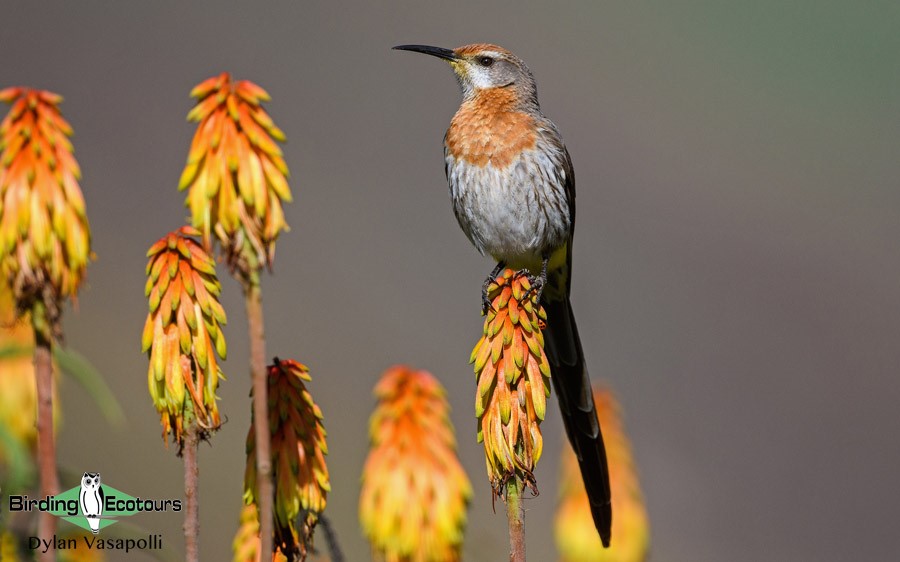
Day 4. Birding the Underberg area, and transfer to Eshowe
We have the morning available to bird the greater Underberg region, which will likely see us visiting a variety of grassland, wetland and forest sites. The rare Wattled Crane will be one of our main targets, as they breed locally within the area, but they are nomadic and difficult to find, and we will need some luck to come across this prized bird. Cape Parrot also occur in some of the montane forest patches in the area and will be another key target for the morning. If required, we can also dedicate some time today to finding Blue Swallow. This region is a very birdy area and we’re likely to come across a great many species across the morning ranging from more widespread birds such as Levaillant’s Cisticola, Cape Weaver and Common Waxbill, to more difficult species such as Long-crested Eagle, Denham’s Bustard and Pale-crowned Cisticola. We also have further chances for a similar suite of species to those occurring in the Ingeli or Xumeni Forests (Day 2), should we have missed any of those targets. After a fulfilling morning, we will begin our drive northwards to the small village of Eshowe, where we will likely arrive in the afternoon, with an entire new suite of special birds awaiting us.
Overnight: Birds of Paradise B&B, Eshowe
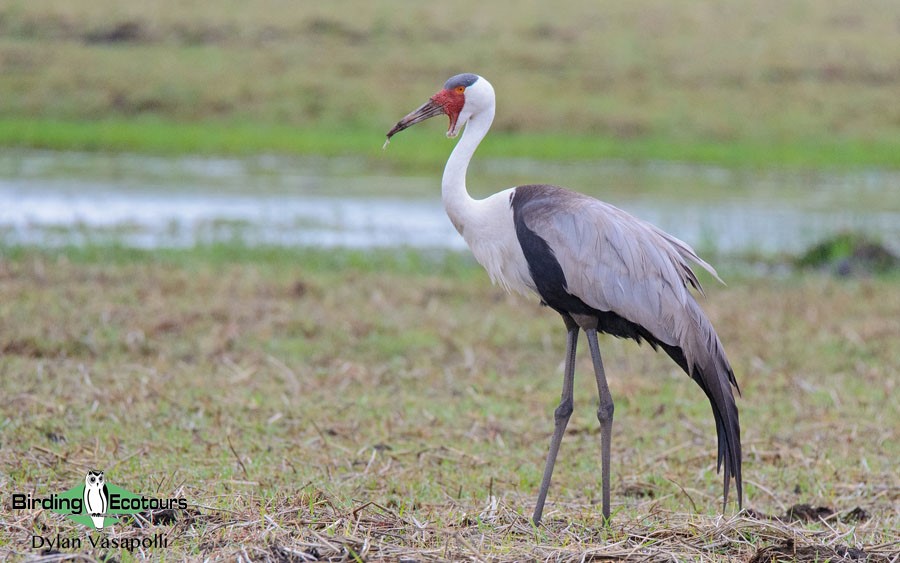
Day 5. Birding Eshowe and surrounds
We have a full day to explore a number of sites within Eshowe, and some lying a bit further afield, which will likely include the Dlinza Forest Aerial Boardwalk, Entumeni Forest, Ongoye Forest, and the coastal town of Mtunzini. Our day will likely start off at the Dlinza Forest, located right in the heart of Eshowe, where the secretive and highly sought-after Spotted Ground Thrush will be one of the main targets. While slowly walking the forest trails, listening for the tell-tale call of the thrushes, we are sure to come across many other birds, and in particular we’ll keep an eye out for Green Malkoha, Lemon and Tambourine Doves, Scaly-throated Honeyguide, Grey Cuckooshrike, Common Square-tailed Drongo, Chorister Robin-Chat, Dark-backed Weaver and the prized Green Twinspot. The forest also features a canopy walkway and tower, and we’ll be sure to spend time up here, as it is a great area to see the rare Eastern Bronze-naped Pigeon (although we will need some luck to see this bird), while more regular birds seen above the forest include African Goshawk, Trumpeter Hornbill, Crowned Hornbill, White-eared Barbet and Black-bellied Starling.
Entumeni Forest acts as a wonderful backup to many of these species, while also holding a small population of the highly prized African Broadbill, although as ever, some luck is needed. Ongoye Forest is a bit further afield and preserves the only southern African population of Green Barbet (with the nearest population found roughly ~1000miles/1600kilometres further north in Malawi and northern Mozambique) – this localized population being of particular interest as it’s a separate subspecies, at times split into a full species restricted to a single forest here at Ongoye! A similar suite of forest birds occurs here as in Dlinza Forest, along with the star of the show, Green Barbet.
The coastal town of Mtunzini presents us with a different, coastal, habitat set, and along with it, a different assemblage of bird species. While our core target here will be the vegetarian Palm-nut Vulture, we’re also likely to find a wide array of other species such as Woolly-necked Stork, Black-throated Wattle-eye, Rufous-winged Cisticola, Purple-banded Sunbird and Yellow-throated Longclaw, amongst many others.
Overnight: Birds of Paradise B&B, Eshowe
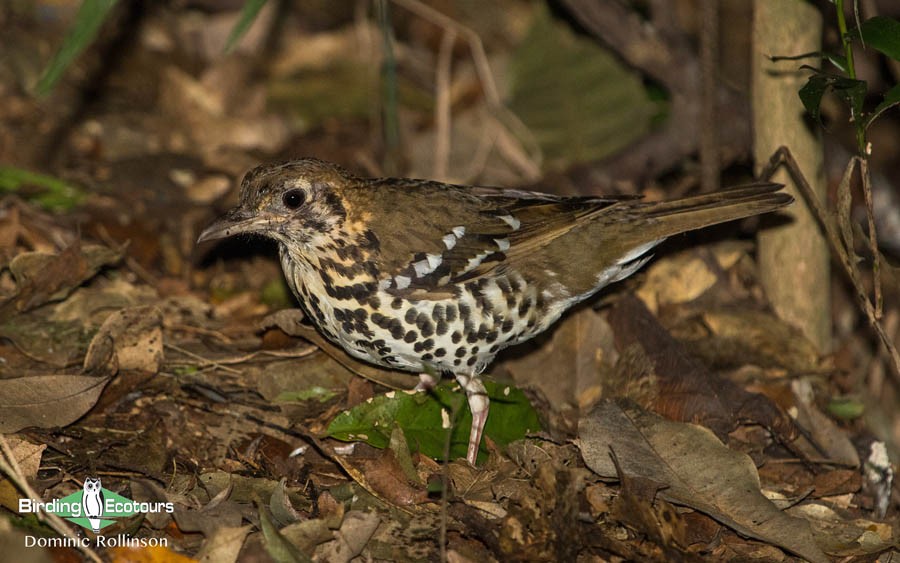
Day 6. Birding around Eshowe and transfer to St Lucia
We have the full morning available to continue birding this area, searching for any of the species we may still need, as mentioned under Day 5 above. We have a short transfer (roughly two hours) to reach our next destination – the lovely coastal village of St Lucia, where we will be based for two nights, and we will likely arrive in the early afternoon. St. Lucia is a wild place, where hippos can still roam the streets at night and Thick-tailed Galagos (Bush Babies) cry from the tree-lined main street at night. This village is completely surrounded by a World Heritage Site, the Isimangaliso Wetland Park, and is a truly phenomenal birding area. Our afternoon will likely see us investigating the estuary and the surrounding coast. Although tidal to some degree, the estuary is largely cut off from direct access to the ocean and as such doesn’t fluctuate heavily. During low-water periods, a number of shorebirds/waders occur here and we’ll be on the lookout for species such as Grey, Common Ringed and White-fronted Plovers, Eurasian Whimbrel, Ruddy Turnstone, Terek, Curlew and Marsh Sandpipers, Common Greenshank and Little Stint. Occasionally rarer species turn up, such as Bar-tailed Godwit, and Greater and Lesser Sand Plovers. There is often a large tern roost present here, and one of our main targets will be the scarce Lesser Crested Tern, while more common species include Greater Crested (Swift), Sandwich, Caspian, Common and Little Terns. The estuary area also supports an array of other waterbirds, and we’re likely to see the impressive Goliath Heron here, with a supporting cast including Grey Heron and Great and Little Egrets, while Yellow-billed Stork is regular along with Pink-backed Pelican. The impressive Saddle-billed Stork can also be seen, but is easier to find in the Kruger National Park later in the tour. Vocal African Fish Eagles are never far away, with a number of pairs breeding in the area. The reedbeds host colonies of the prized Southern Brown-throated and Eastern Golden (Yellow) Weavers. The estuary is also home to Nile Crocodiles, and quite a few pods of Hippopotamuses, some of which call the St Lucia village home, and can even be seen in the evenings walking around the town grazing on lawns!
Overnight: St Lucia Wetlands Guest House, St Lucia
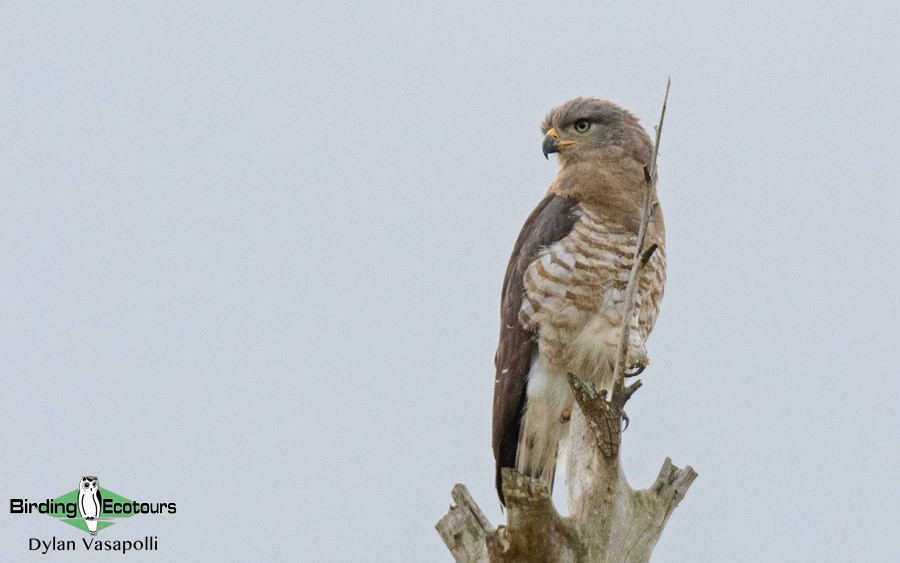
Day 7. Birding the UNESCO World Heritage Site, Isimangaliso Wetland Park
We will spend the day exploring the wonderful Isimangaliso Wetland Park, which is a UNESCO World Heritage Site, and will likely spend time in both the Eastern and Western Shores section of the park. While primarily consisting of coastal grassland, patches of coastal forest occur as well, and host a fine array of unique and special birds which we’ll spend time trying to find. These include the sought-after Southern Banded Snake Eagle, the glorious Livingstone’s Turaco, Narina Trogon, Woodward’s Batis, the spectacular (but difficult-to-see) Gorgeous Bushshrike, Brown Scrub Robin, Eastern Nicator, localized Rudd’s Apalis and Grey Waxbill, among others. We won’t ignore the more open areas, as they do also host some great birds and birding; some of the species we’ll be sure to keep an eye out for include Black-bellied Bustard, Senegal Lapwing, Collared Pratincole, Croaking Cisticola, Lemon-breasted Canary, and with some luck, Rosy-throated Longclaw. A number of raptors hunt over these open areas, and it’s a great place to see a wide range of these species. These open areas also support good numbers of Swamp Nightjar, and with some birding in strategic areas after dark, we stand a good chance of finding this prized bird.
Not to be forgotten, this park also supports a wide array of mammals, and we may see such charismatic species as African Elephant, African Buffalo and Giraffe, along with antelope such as Waterbuck, Impala and the dainty Red Duiker. This is also a great area to see the scarce Blue (Samango) Monkey, while species such as Leopard and White Rhinoceros will require a bit more luck to find. This is a very birdy park, and we’re sure to rack up a high list of birds for the day.
Overnight: St Lucia Wetlands Guest House, St Lucia
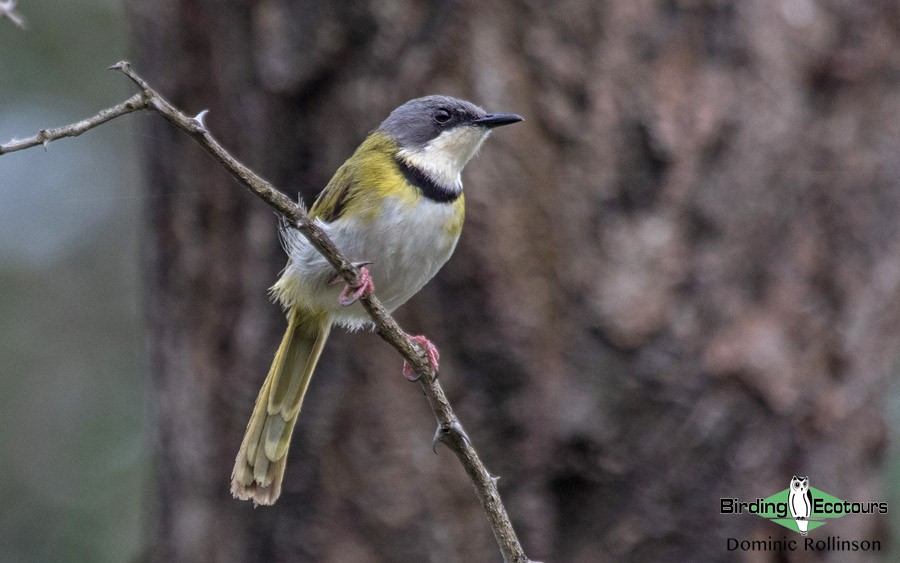
Day 8. Birding St Lucia and transfer to Hluhluwe
We have the morning available to bird around the village, and in particular, along the lovely iGwalagwala Trail, which passes through some excellent coastal forest. Although we should have seen many of these specials the previous day, it serves as an excellent backup for species we could have missed, including some very localized birds like Livingstone’s Turaco, Woodward’s Batis, Brown Scrub Robin, Rudd’s Apalis and Grey Waxbill, while also offering chances for species such as Buff-spotted Flufftail (with some luck and patience), Green Malkoha, Blue-mantled Crested Flycatcher, Yellow-bellied Greenbul, Terrestrial Brownbul and others. Strange-looking Crested Guineafowl are a common sight around the village as well and are sure to keep us entertained.
We have another short transfer (also roughly two hours) to get to the Hluhluwe area, where we’ll be based for two days, as we explore the mega-diverse but compact Mkhuze Game Reserve and surrounds. This is arguably one of the finest birding sites in southern Africa and certainly has a legendary status. We’ll likely arrive at our comfortable lodge in the early afternoon, and may explore some of the surrounding open areas, such as Mpempe Pan or the Nibela Peninsula this afternoon still. The birding here can be excellent, and some of the species we’re likely to see include Black-winged and Senegal Lapwings (sometimes offering great comparative views of these similar birds, both of them scarce and local), Collared Pratincole, Grey-rumped Swallow, all three locally occurring Longclaws (Cape, Yellow-throated and Rosy-throated), and the highly range-restricted Lemon-breasted Canary. A wide array of ducks, geese, herons, egrets and other waterbirds can also be seen here.
Our lodge itself also hosts some excellent birding and we’re likely to become acquainted with a number of sand forest specials here (sand forest is a delightful, localized habitat typical of Zululand and southern Mozambique, and contains some top birds). The highly sought-after Pink-throated Twinspot occurs commonly around the lodge and will be one of our main targets here. A number of other sought-after birds, which we may not yet have seen, are possible here as well, including Green Malkoha, Red-fronted Tinkerbird, Rudd’s Apalis, Eastern Nicator, Bearded Scrub Robin, White-throated Robin-Chat and Purple-banded Sunbird. More widespread species found here include a wide array of cuckoos, including African Emerald-, Klaas’s, Red-chested and Black, Striped Kingfisher, Orange-breasted Bushshrike, Black-crowned Tchagra, Black Cuckooshrike, Southern Black Tit, Violet-backed Starling, Pale Flycatcher, Scarlet-chested Sunbird and Golden-breasted Bunting, amongst others. Noisy Thick-tailed Greater Galagos (Bushbaby) wake up in the evenings, and can often be seen around the lodge. We’ll enjoy a good evening meal, in preparation for another excellent day in the heart of Zululand.
Overnight: Umkhumbi Lodge, Hluhluwe
Day 9. Birding Mkhuze Game Reserve and surrounds
We will undertake a day trip into the nearby Mkhuze Game Reserve (armed with picnic breakfast and lunch). This tiny reserve is one of the premier birding sites in the country. One is only allowed out of the van in designated areas (because of the presence of dangerous African megafauna), and so we will focus our birding on the excellent hides (and walkways to them), picnic sites and around the rest camp, where we are free to get out and walk around. This incredible reserve has a wide array of habitats, ranging from bushveld through to sand forest, and open wetlands, and we’ll explore all of these habitats during our day. The sand forest is home to our main targets, which will include the likes of Pink-throated Twinspot (if not seen previously), Neergaard’s Sunbird and Gorgeous Bushshrike, among other prized birds such as Rudd’s Apalis, African Pygmy Kingfisher, Red-fronted Tinkerbird, the diminutive Grey Penduline Tit, Eastern Nicator, the attractive Stierling’s Wren-Warbler and Dusky Indigobird. The large Nsumo Pan also offers excellent birding, supporting a wide array of waterbirds, and depending on the water levels at the time, the pan supports one of the only breeding colonies of Pink-backed Pelicans in South Africa. Other species to be found here include the likes of the sought-after African Pygmy Goose and African Openbill while more regular birds include White-faced Whistling Duck, Black Crake, Water Thick-knee, African Jacana, Whiskered Tern, African Spoonbill, Squacco and Black Herons and Pied Kingfisher. The trees on the edge of the pan support the dazzling Broad-billed Roller, along with an array of woodpeckers, kingfishers, barbets, honeyguides, bushshrikes, flycatchers, robins, sunbirds and weavers. Pel’s Fishing Owl do occur in the area, but are nomadic and very rarely seen, and are more reliable on our tour to the Okavango Delta in Botswana/northern Namibia.
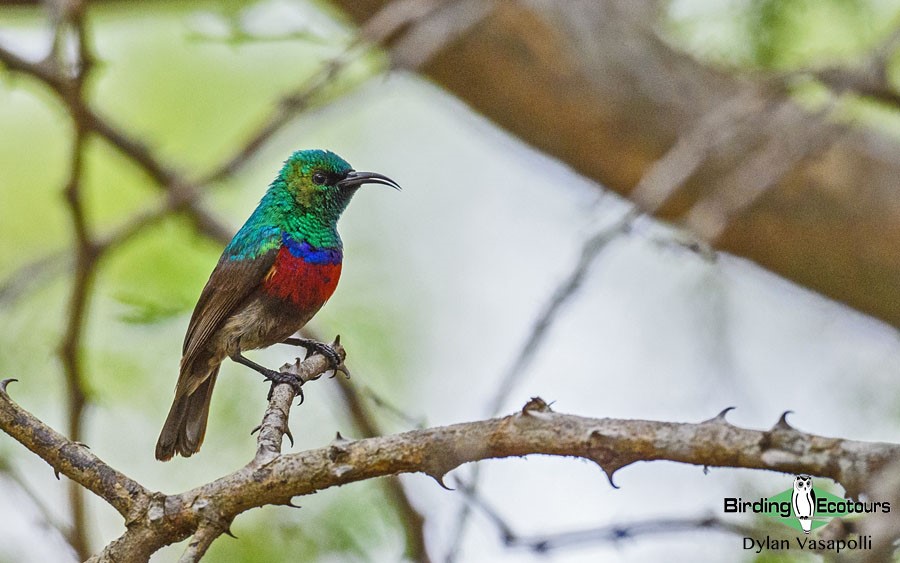
The park will also allow us to increase our raptor list, being an excellent area for some of the more iconic bushveld species such as Bateleur and Martial Eagle, while White-backed Vultures are never far away. The bushveld areas are not to be ignored, and are home to species such as Common Scimitarbill, Southern Yellow-billed Hornbill, Lilac-breasted Roller, Chinspot Batis, Brubru, Sabota Lark, Long-billed Crombec, Burnt-necked Eremomela, Red-billed Oxpecker (often catching a ride on large mammals), Kurrichane Thrush, Blue Waxbill and Green-winged Pytilia, among others.
In addition to all these excellent birds, Mkhuze also offers a wide selection of mammals including the full complement of big game species. While mammals such as Lion, Cheetah, African Wild Dog, Leopard, African Elephant and Black and White Rhinoceros occur, they are scarce and we’ll need some luck to find these. More commonly seen species include an array of antelope, including the spectacular Nyala, along with Greater Kudu and the ever-charismatic Plains Zebra. The diminutive Suni antelope can also be seen in the sand forest.
This is sure to be an excellent day, with a high number of birds and mammals seen. We’ll return to our comfortable lodge for a well-deserved dinner later in the afternoon.
Overnight: Umkhumbi Lodge, Hluhluwe
Day 10. Birding Hluhluwe and transfer to Wakkerstroom
We have the morning available to bird the excellent grounds of our lodge, or some other nearby areas, such as False Bay Nature Reserve, should any target species still be outstanding – these may include the likes of the difficult African Broadbill and Neergaard’s Sunbird. We’ll then begin the fairly long drive (4 hours+), to get to our next destination, Wakkerstroom, set in the montane grassland belt at high altitude. This is another one of the premier birding destinations in the country, and is a must for any world birder, as it hosts a number of prized endemic birds. Wakkerstroom is a lovely, quaint and charmingly small village located along the Drakensberg escarpment, and as such is fairly high in elevation (only just below 6500ft/2000m). We will likely only arrive in the afternoon and may begin exploring the area slightly lower in elevation located to the east of the town. Here, a number of species not regularly seen in the immediate vicinity of the town can be seen and include the likes of the curious southern African race of White-bellied Bustard (known locally as Barrow’s Korhaan, split by some authorities), and Cloud Cisticola. We’re also sure to get our eye in on some of the other more widespread grassland species occurring in the area, such as Swainson’s Spurfowl, Cape Crow, Spike-heeled and Red-capped Larks, South African Cliff Swallow, Banded Martin, Cape Grassbird, Pied Starling, Ant-eating Chat, Capped Wheatear, Red-collared Widowbird, Cape Longclaw and Cape Canary, amongst others.
Overnight: Forellenhof Guest Farm, Wakkerstroom
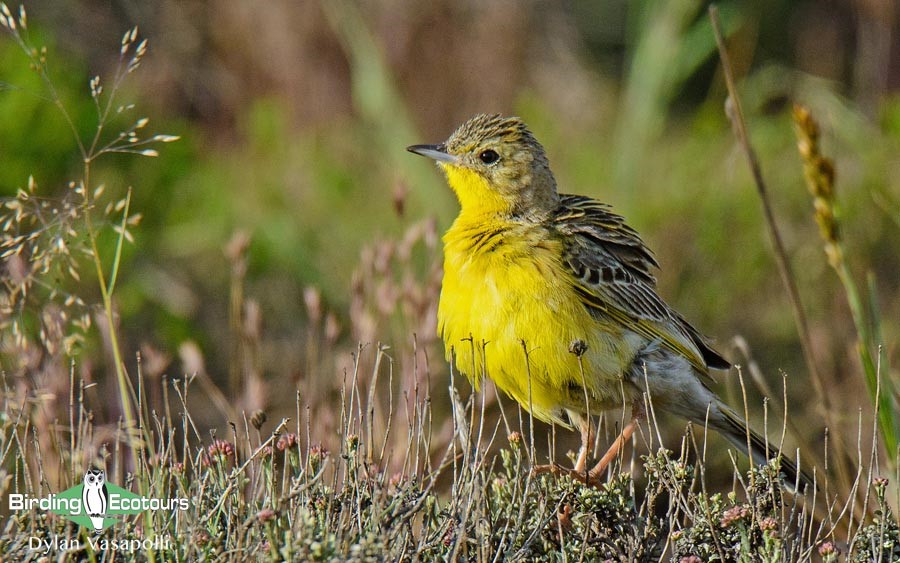
Day 11. Birding the Wakkerstroom area
We will have a full day of birding the upland grasslands and wetlands surrounding Wakkerstroom, and we usually make use of a local guide. Our day will center around the three ‘big’ targets of the Wakkerstroom area – Rudd’s and Botha’s Larks and Yellow-breasted Pipit. These endemic species are all rare and localized, with the grasslands around Wakkerstroom proving one of the few and only reliable locations to find these prized species. The entire area is particularly species-rich with many of the following likely: Red-winged and Grey-winged Francolins, Southern Bald Ibis, Denham’s Bustard, Blue Korhaan, Eastern Long-billed, Pink-billed and Eastern Clapper Larks, Pale-crowned and Wing-snapping Cisticolas, Nicholson’s Pipit and Cape Bunting. The wetlands in the area are home to a number of birds, and amongst others we will search for White-backed and Maccoa Ducks, African Rail, Red-chested Flufftail (with some patience), African Snipe and Little Bittern. Aside from these, many other more widespread grassland species feature here, from Blue and Grey Crowned Cranes, to a variety of raptors, cisticolas, larks, widowbirds, weavers and more. Areas of woodland line some of the ravines and valleys, and these provide us with further species such as Red-throated Wryneck, Bokmakierie, Lazy Cisticola, Drakensberg Prinia, along with Bush Blackcap and Barratt’s Warbler in the wooded areas. We will also be sure to keep our eyes to the sky for raptors such as the tricky Rufous-breasted Sparrowhawk, along with Black Sparrowhawk, and African Marsh and Black Harriers. This is also a great area for aerial feeders (swifts, swallows and martins), and we’ll also keep an eye out for the tricky Horus Swift, along with Alpine and African Black Swifts.
While few of Africa’s larger mammals are found here, this area is a great place to find smaller mammal species such as the charming Meerkat as well as Yellow Mongoose and Common Duiker. After dark, we can also try for Marsh Owl, and if we’re lucky, the rare African Grass Owl.
Overnight: Forellenhof Guest Farm, Wakkerstroom
Day 12. Birding Wakkerstroom, and transfer to the Kruger National Park
We have the morning available to try for any highland birds we may still be missing, before having to gather our things and set off to our next destination. We have arguably the longest drive of the trip today (roughly 6 hours), but the reward is that we’ll eventually arrive in one of Africa’s greatest game parks – the Kruger National Park. We will spend three nights in this great park attempting to find as many of the birds and mammals mentioned below as possible, along with enjoying a great safari experience. The mammal and bird diversity here is nothing short of staggering. African Elephant, Hippopotamus, Lion, Leopard, Cheetah, African Wild Dog (now extremely rare but regularly sighted in the park), both White and Black Rhinoceros, Giraffe, and a stack of antelopes and smaller mammals will all be sought. Nile Crocodile is quite common in many of the park’s waterbodies. The park is absolutely full of birds as well, including a mega-diversity of raptors (ranging from the tiny Little Sparrowhawk to the massive Lappet-faced Vulture, and a great many in between), an array of storks, the most admired being Saddle-billed Stork, while on the other end of the spectrum ‘the undertaker’ Marabou Stork, and other large birds such as Southern Ground Hornbill. Indeed, the raptors and other large birds thrive here, as there is such a vast amount of conserved and wild land, allowing them to breed largely away from human disturbance – making this a stronghold for these species in South Africa. A great many other species occur, and include a number of francolins, cuckoos, hornbills, rollers, mousebirds, kingfishers, bee-eaters, woodpeckers, bushshrikes, flycatchers, robin-chats, starlings, waxbills, firefinches, canaries and buntings. The diversity of birds and mammals in the park has to be seen to be believed, and we will accumulate a long list of species during our stay in the park.
Overnight: Skukuza Rest Camp or similar, Kruger National Park
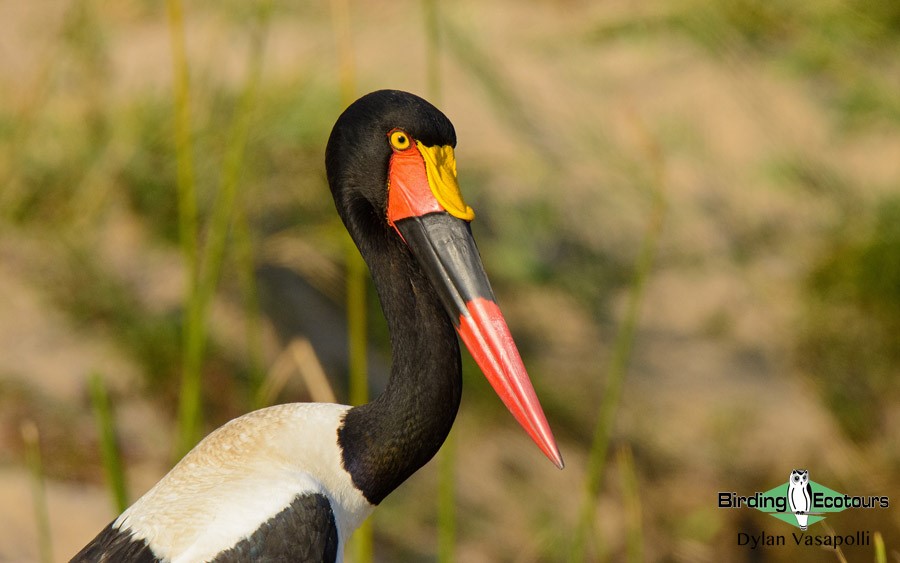
Days 13 – 14. Birding the Kruger National Park
Making use of open-top safari vehicles, ideal for bird and game viewing in Kruger, we have two full days to explore the southern areas of this iconic park. Our exact routes may vary depending on which rest camp(s) we stay at, but we stand good chances at finding most of the above-mentioned (Day 12) species. We will also have the opportunity to undertake optional night drives (at your own cost), which can produce some of the scarcer nocturnal birds, such as Bronze-winged Courser and Verreaux’s Eagle-Owl, and mammals such as African Civet, South African Large-spotted Genet and perhaps even Serval.
Overnight: Skukuza Rest Camp or similar, Kruger National Park
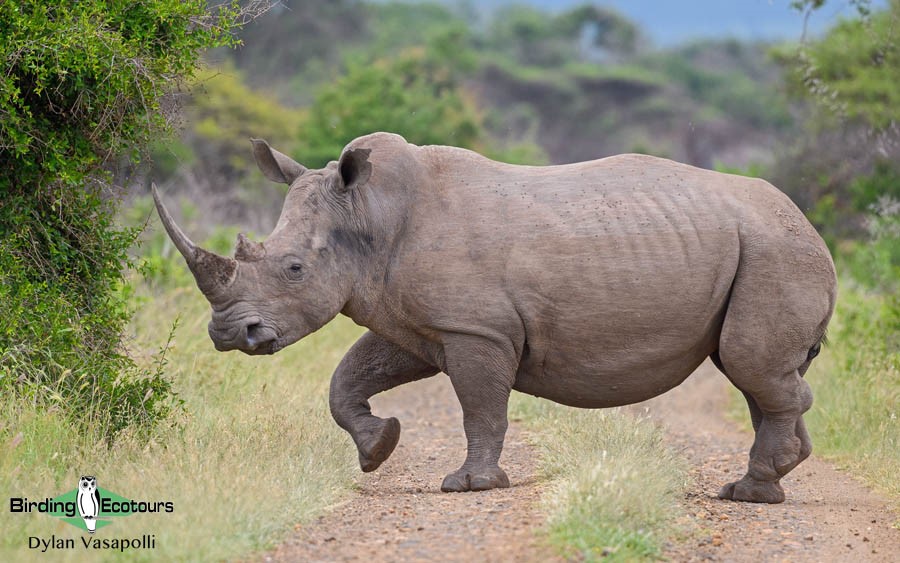
Day 15. Birding Kruger, with a transfer to Dullstroom
We have our final morning available to spend within Kruger, before having to exit this wonderful area, and continue onto our next destination, that being Dullstroom, located in the highlands of the northern Drakensberg escarpment. The drive will likely be around 3 hours and should see us arriving with time to spare in the afternoon, where we’ll check into our very comfortable lodge and acquaint ourselves with the area and some of its birds. Dullstroom is a small, charming village which plays host to a number of specials which we’ll be targeting during our time here. Foremost amongst these is the rare Cape Eagle-Owl, which we will attempt to track down this evening.
Overnight: Linger Longer Country Retreat, Dullstroom
Day 16. Birding Dullstroom, and transfer to Rust de Winter
We have the morning available for some final birding around Dullstroom and surrounds. We usually focus our efforts on the nearby Verloren Vallei Nature Reserve, which hosts some of the most pristine montane grassland in the area. While we should have seen many of the species occurring here previously on the trip in the other highland areas (Wakkerstroom and Sani Pass), this stunning area offers us an excellent backup for a number of scarce and prized birds, such as Wattled Crane, Secretarybird, Denham’s Bustard, Red-winged Francolin, Southern Bald Ibis, Black-winged Lapwing, Gurney’s Sugarbird, Eastern Long-billed Lark and Yellow-breasted Pipit.
We will eventually make our way onwards to our final destination, Rust de Winter, and have a relatively lengthy transfer (roughly 4 hours) to get here. We will likely take an ‘off-the-beaten-path’ route to get here, visiting some of the superb mixed broad-leafed woodlands north-east of Pretoria, which support some localized and scarce species. Here we can search for Shelley’s Francolin, Melodious and Fawn-colored Larks, Green-capped Eremomela, Short-toed Rock Thrush, Tinkling Cisticola, Bushveld Pipit and Red-headed Weaver. If conditions are right, we may also be able to find the incredibly difficult White-backed Night Heron and Half-collared Kingfisher. We will eventually arrive at our comfortable lodge located in the Rust de Winter district in the late afternoon.
Overnight: Golden Impalas Bush Resort, Dinokeng Game Reserve
Day 17. Birding Zaagkuilsdrift, Kgomo-Kgomo and Rust de Winter
We will spend the last full day of the tour birding the rich “acacia”-dominated savannas and other habitats of the area. We usually focus our efforts on the superb Zaagkuilsdrift Road, which offers a great transect through this habitat, and puts us in an excellent position to find some of the many more typical Kalahari edge type species that occur here. The road continues on for a while through bird-rich savannah before arriving at a floodplain, which also hosts some excellent species, but birding here is very much dependent on the conditions (usually dry on our October tours). This is another of the country’s premier birding sites, with a huge diversity of birds, and we’re sure to build up an extensive list of species. Some of the Kalahari-type birds we’ll try for include Northern Black Korhaan, Crimson-breasted Shrike, Southern Pied Babbler, Kalahari Scrub Robin, Barred Wren-Warbler, Chestnut-vented Warbler (Tit-babbler), Cape Penduline Tit, Burnt-necked Eremomela, Marico Flycatcher, Violet-eared and Black-faced Waxbills, Great Sparrow, Cut-throat Finch, Scaly-feathered Weaver (Finch), White-browed Sparrow-Weaver, Shaft-tailed Whydah and Yellow Canary. These are just a few of the many birds occurring in the thornveld, and the usually dry (at this time of the year) and open lands around the floodplain can support interesting birds such as Temminck’s Courser and Caspian Plover.
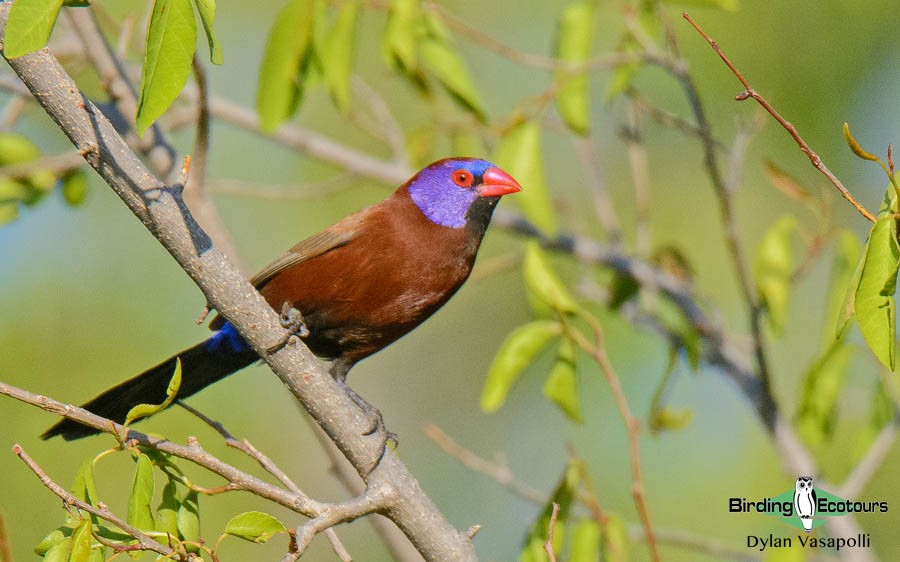
The nearby Rust de Winter area supports a similar suite of birds to those mentioned above. This is also a great area to get to grips with owls, and some dedicated nocturnal searching may produce the likes of Western Barn, Southern White-faced and African Scops Owls, while the larger Spotted and Verreaux’s Eagle-Owls do occur in the area as well. The dainty and partly diurnal Pearl-spotted Owlet is ever-present too, sometimes surrounded by a host of passerines mobbing it (which is useful to us as it means we can accumulate a lot of bird species fast!). We’ll eventually settle in for our last dinner together, reminiscing about all the excellent birds we’ve experienced over the course of this tour.
Overnight: Golden Impalas Bush Resort, Dinokeng Game Reserve
Day 18. Transfer to Johannesburg and departure
We have the morning available to bird and explore the surrounds at our leisure, and being no more than 2 hours away from the main Johannesburg Airport (OR Tambo International Airport), we do not have very far to travel today. The tour will conclude at the airport later in the day.
We kindly ask that you book your international flight to depart after 3 p.m. today.
Please note that the itinerary cannot be guaranteed as it is only a rough guide and can be changed (usually slightly) due to factors such as availability of accommodation, updated information on the state of accommodation, roads, or birding sites, the discretion of the guides and other factors. In addition, we sometimes have to use a different guide from the one advertised due to tour scheduling, or other factors.
Download ItinerarySubtropical South Africa Trip Report
14 – 31 October 2024
By Joshua Olszewski
DOWNLOAD TRIP REPORT

The magnificent Saddle-billed Stork was one of the highlights from our time in Kruger!
Overview
From high mountains to humid coastal forests, desert to savanna woodland, South Africa has a variety of habitats that is hard to match. This, in turn, has led to an even more impressive variety and abundance of plant and animal species, many of which are found nowhere else in the world. The bird diversity is particularly noteworthy, with over 850 species on offer across the different ecozones. On this 18-day tour, we spent much of our time traversing the warm subtropical forests and savannas in the east of South Africa, making brief forays into the cooler, more temperate grasslands and mountainous regions like Wakkerstroom, Dullstroom and Sani Pass in the Drakensberg Mountains.
Across all these biomes, we managed to amass a list of over 400 bird species, with notable highlights including Drakensberg Rockjumper, Bearded Vulture, Pink-throated Twinspot, Narina Trogon, Livingstone’s Turaco, Rudd’s Lark, Martial Eagle, Wattled Crane, African Skimmer, Orange Ground Thrush, Crimson-breasted Shrike and Southern White-faced Owl amongst many others. Our days in the famous Kruger National Park provided us with impeccable mammal sightings which included multiple Leopards and a pack of African Wild Dogs that we saw in excess of three times!
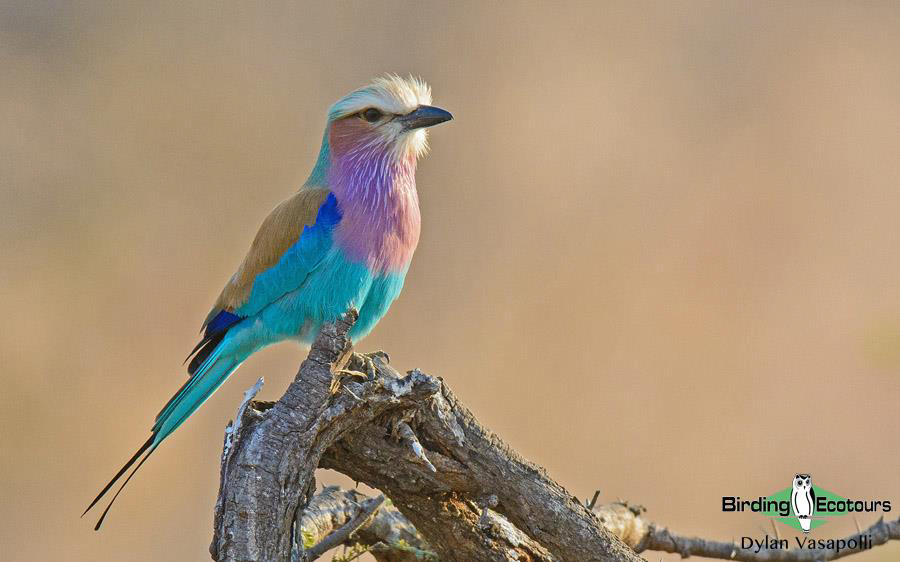
It’s hard to beat the vivid beauty of the Lilac-breasted Roller, especially against the backdrop of brown and green savanna.
A detailed daily account can be read below, and the full bird and mammal lists are located at the end of the report.
Detailed Report
Day 1, 14th October 2024. Arrival in Durban, local birding and transfer to Pennington
Most of the tour group was already staying in Durban from the previous day, and had great views of Cape Starling, African Woolly-necked Stork and Hadada Ibis upon leaving their accommodation at Mount Edgecombe this morning. However, this was essentially a travel day, as the tour participants made their way to Botha House in the picturesque Umdoni Park Golf Estate, south of Durban, along the coast. Not much birding was done this afternoon once we had arrived at Botha House, due to the wind and rain, so we decided to call it in and enjoy dinner and some great conversations about all the great birds we were to see over the next two weeks.
Day 2, 15th October 2024. Birding Umdoni Park, and transfer to Underberg, via Ixopo
Before breakfast we went out for an early morning walk through the lush forests around Umdoni Park. This got us adjusted to some of the local forest species, such as Tambourine Dove, Yellow-bellied Greenbul, Purple-crested Turaco, Olive, Grey and Collared Sunbirds, Black-headed Oriole, Red-capped Robin-Chat, Ashy and Southern Black Flycatcher, Yellow-rumped Tinkerbird, Square-tailed Drongo and Bar-throated Apalis. Other interesting species seen on the verges of the forest included Southern Black Tit, Green Wood-Hoopoe, Thick-billed Weaver, Tawny-flanked Prinia and a brief Crowned Eagle seen by some of the clients. A large flock of swallows flying overhead consisted mostly of Lesser Striped Swallows, along with smaller numbers of Black Saw-wings and Brown-throated, Large Rock and Western House Martins.After breakfast, we ambled around the gardens surrounding the house, which delivered the localized Southern Tchagra, as well as Yellow-fronted Canary, African Pied Wagtail, Brown-hooded Kingfisher, Village Weaver, Cape Robin-Chat, a responsive Cardinal Woodpecker and both White-eared and Black-collared Barbets.
We then left Pennington and headed inland towards the Drakensberg, making a midday stop near the village of Ixopo. Here we tried for Blue Swallow, which did not show, but we did manage to find African Firefinch, Buff-streaked Chat, Southern Boubou, African Stonechat and a confiding pair of Brimstone Canaries. We pushed on towards the Drakensberg, being treated to fly-bys from Jackal Buzzard, White-necked Raven, and Yellow-billed Kite. Upon taking the gravel road down to our scenic lakeside accommodation, we connected with Bokmakierie, Red-collared Widowbird and interesting waterbirds along the lake shore. These included Little Grebe, Yellow-billed Duck, Levaillant’s Cisticola and, best of all, a pair of Wattled Cranes! These elegant birds are sparse and uncommon in South Africa, so bumping into this pair was really special. We then turned in for the evening, enjoying Common Moorhen, Grey Heron, Pied Kingfisher, Blacksmith Lapwing, and Yellow-billed Duck on the ponds outside our chalets, before settling down for dinner..

It was a great surprise to find a pair of Wattled Cranes near our Drakensberg accommodation.
Day 3, 16th October 2024. Endemic birding on Sani Pass, and into Lesotho
Today was a fantastic day of birding along the spectacular Sani Pass: a 15-kilometer-long mountain pass that ascends the dramatic Maluti-Drakensberg Mountains and crosses the border into Lesotho at the top. The farmsteads near the bottom of the pass were our first port of call. These delivered interesting species like African Paradise Flycatcher, Olive Thrush, Golden-tailed Woodpecker and a showy young Bush Duiker. Further along, the grassy, boulder-strewn slopes and valleys along the pass started to give up some proper Drakensberg and Afromontane specials. These included the endemic Gurney’s Sugarbird, as well as Rock Kestrel, Wailing Cisticola, Malachite and Greater Double-collared Sunbird, Buff-streaked Chat, Nicholson’s Pipit, Cape Rock Thrush, Yellow Bishop, Cape Grassbird and the bizarre Ground Woodpecker. The noisy Red-throated Wryneck was also found in this area, and the loud calls of Barratt’s Warblers rang out from every gulley filled with thickets of woody Ouhout shrubs (though we would have to wait until later in the day before laying eyes on one of these secretive warblers).
The Ouhout thickets around the South African border post produced several interesting species, like Drakensberg Prinia, Streaky-headed Seedeater, the attractive African Yellow Warbler and an unexpected Willow Warbler (an early arrival from Europe). A Karoo Prinia was also found in one of these Ouhout thickets further down the pass; rather unusual considering this is normally where one sees the Drakensberg Prinias,while the Karoo Prinias tend to stay in the scrubbier karroid vegetation on top of the pass.
This drier, scrubby habitat became more prevalent as we ascended the last few kilometers of the pass. Here, the vistas over the valley behind us were simply breathtaking as we trudged up the rugged switchbacks. One of these switchbacks was especially productive, as it delivered our first looks at Drakensberg Siskin and very close views of a male Drakensberg Rockjumper. Bathing in the adjacent stream and foraging meters beneath our feet, we were treated to impeccable views of this gorgeous, charismatic and highly sought-after endemic.
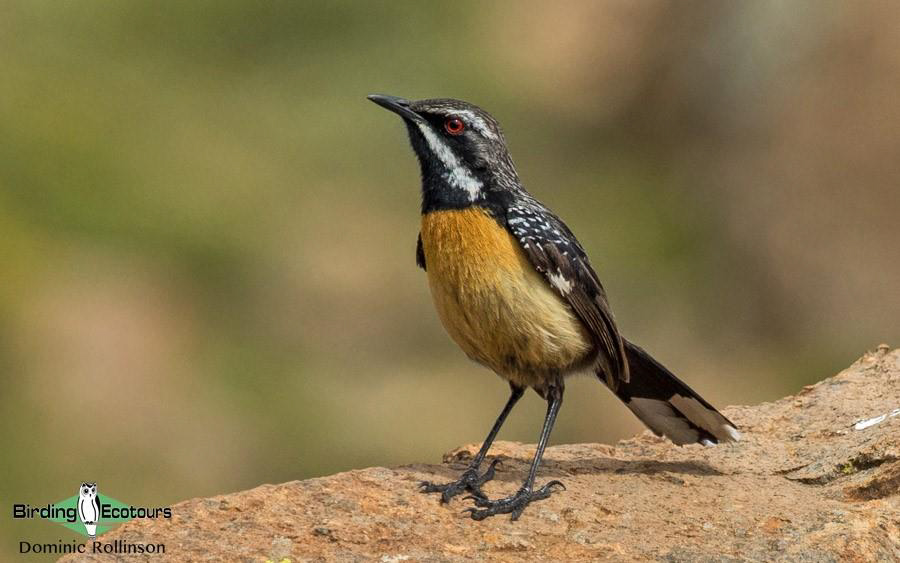
Rockjumpers are an endemic southern African family, and the Drakensberg Rockjumper is always a major target on Sani Pass.
After going through the border control at the top of the pass, we journeyed over the vast expanse of rolling plains and mountains covered in low karroid scrub. With this drastic change in habitat from the bottom of the pass, came a whole new suite of birds. Some of the first that we connected with included Large-billed Lark, Sickle-winged Chat and the colorful Sentinel Rock Thrush. We stopped for a roadside lunch break (which was delicious, courtesy of our local guide, Stuart) a few kilometers down the road, which proved to be quite fruitful. A majestic young Bearded Vulture came flying low overhead multiple times during this time, seeming to investigate the surrounding slopes for bones. Other raptors seen included a pair of Lanner Falcons, a Verreaux’s Eagle being chased by a pair of Jackal Buzzards and a couple of Cape Vultures. The scrub around our lunch spot was not to be outdone, and produced Layard’s Warbler, Fairy Flycatcher and Cape Bunting.
After lunch, we started on the journey back, carefully scanning and working the roadside plains for one of our main targets. Eventually, after some struggling, we managed to connect with two pairs of Mountain Pipit, one even collecting food! The old stone ruins just before the border control gave us much better views of a pair of Drakensberg Siskins, as well as the cute Sloggett’s Vlei Rat and our first Red-capped Larks of the trip. Shiny Cape Crows and Southern Bald Ibis walked around the grassy patches near the border control offices, which were home to several attractive Cape Sparrows. After once again passing through border control back into South Africa, we slowly descended the switchbacks, relishing the golden evening light being thrown across the green and yellow valley below us. A couple of Rock Hyrax were sunning themselves on the roadside boulders as we went. Returning to our lodge, we once again scanned the lake as we arrived, which delivered many of the same species we had already seen, with the addition of a single Common Greenshank, and vibrant Cape Longclaws in the surrounding grass. Close views of Pied Starling were also welcome, and returning to the lake shore after dark delivered a roosting family of South African Shelducks, complete with five fledglings. Mountain Reedbuck and a lone Scrub Hare were also some of the nocturnal additions to the trip list.
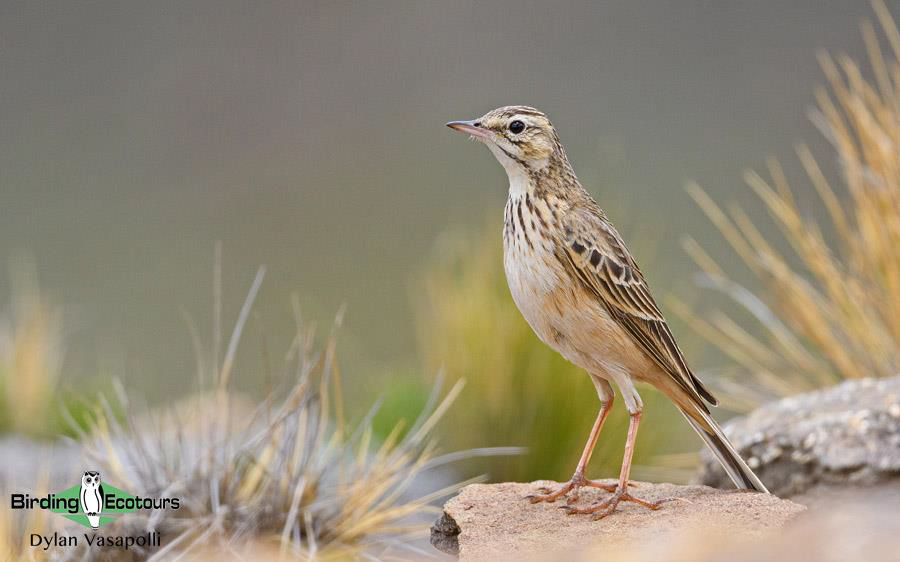
Although Mountain Pipit breeds in the high Drakensberg mountains, their non-breeding range still remains a mystery!
Day 4, 17th October 2024. Sani Valley and Benvie Gardens, transfer to Eshowe
We decided to take an early morning walk around the small lakes directly in front of our chalets at Sani Valley Lodge. With good lighting, we enjoyed views of African Swamphen, Yellow-billed, Great and Little Egrets, Grey Heron, Pied Kingfisher, White-faced Whistling Duck, Reed and White-breasted Cormorant and at least fifteen Black-crowned Night Herons! After leaving Sani Valley, we were once again treated to many Cape Crows, White-necked Ravens and Jackal Buzzards as we journeyed east away from the mountains. It didn’t take long for us to find the first of many Long-crested Eagles we would see that day. Just outside Underberg we stumbled upon a fallow field filled with at least 40 Grey Crowned Cranes, including a very enthusiastic bird doing the famous “crane dance”, though none of his congeners seemed eager to join him! We also made a brief stop at Marutswa Forest in the hopes of getting Cape Parrot, but we had to settle for African Pipit, a showy Amethyst Sunbird and fly-bys from both Long-crested Eagle and African Harrier-Hawk
Later in the day, we made it to the tranquil Benvie Gardens in the Karkloof Conservancy. The pink and red Azalia bushes beneath giant Himalayan pines alongside Afromontane forest create a beautiful, if not unorthodox, environment to see the secretive Orange Ground Thrush. This spot is one of the best places to see this thrush, and we soon found a relaxed pair with a nest right next to the path, seemingly unbothered by our presence. A large mixed flock of Bronze and Black-and-white (Red-backed) Mannikins was also a nice find, as was a pugnacious Green-backed Camaroptera that almost attacked my speaker! The many blossoms in the gardens produced many Southern Double-collared Sunbirds and singletons of Olive and Collared Sunbird.
Leaving Benvie behind, we continued east towards Eshowe, without much more birding, but notably finding another field full of cranes, although this time they were Blue Cranes, South Africa’s national bird. With all three crane species in the bag, we completed the long drive to Eshowe and enjoyed a hearty dinner at our lovely accommodation.
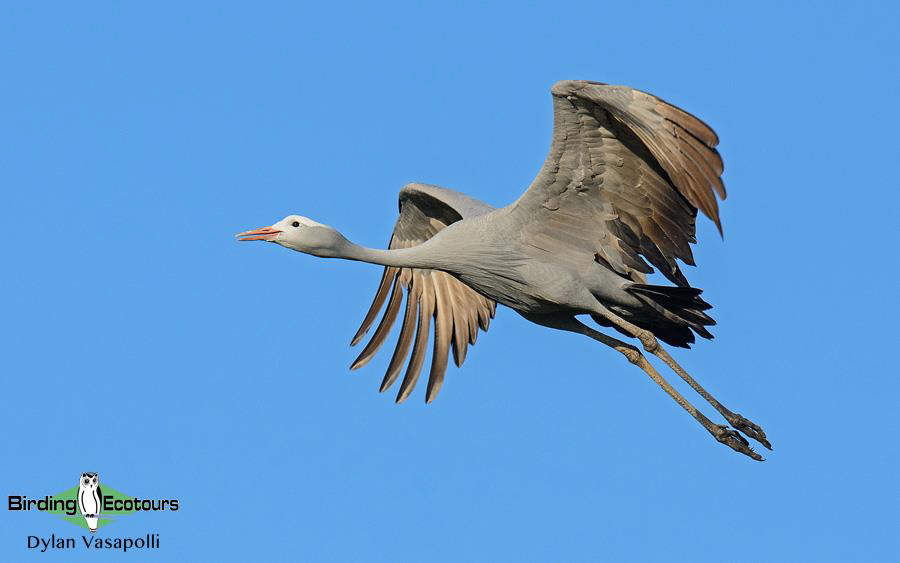
The regal Blue Crane was the last of South Africa’s three crane species to be seen on this tour.
Day 5, 18th October 2024. Birding Ongoye and Dlinza Forests
We made our way down to Mtunzini at sunrise to fetch our local guide, stopping en route in the lush coastal forest near Mtunzini Forest Lodge. As we drove the dirt track towards the lodge, a Palm-nut Vulture flushed from the roadside and sat low down in a tree next to the road. We took the time to enjoy these unusually close-up views of this strange and beautiful raptor. After picking up our guide, Junior, we made another stop in Mtunzini town to enjoy large numbers of Trumpeter Hornbills foraging in a fruiting fig tree. The ringing calls of a Crested Barbet also got our attention, and the bird showed very well alongside the more abundant White-eared Barbets and Yellow-rumped Tinkerbirds. African Pied Wagtails tended the suburban lawns, and other good birds seen in the parks and gardens around town included Violet-backed and Black-bellied Starlings and Purple-crested Turaco.
We then headed north again, this time in the direction of Ongoye Forest. This large patch of Afromontane forest is well known in birding circles for hosting southern Africa’s only population of Green Barbet. The subspecies here, woodwardii, is also endemic to this forest, and differs from those further north in having bright yellow ear coverts. We birded a section of the forest that crossed the main road, and swiftly connected with a pair of these rare barbets singing their hearts out. This stretch of road was very productive, and in an hour we had scored views of Dark-backed Weaver, Cape Batis, Terrestrial Brownbul, Yellow-streaked Greenbul, Brown Scrub Robin and multiple Narina Trogons. The rocky grassland outside the forest gave us a single Plain-backed Pipit, while a Common Buzzard soared overhead with one of the ubiquitous Yellow-billed Kites.
Backtracking towards Mtunzini, the roadside birding kept us entertained with Fan-tailed Widowbirds flying over the cane fields, and African Woolly-necked Storks accompanying the common Hadada Ibis in the fallow fields. Lesser Striped Swallows were frequently seen along the telephone lines, while Rufous-naped Lark was less common. We made an impromptu visit to the grasslands around a small dam near Emoyeni, where we managed stunning views of a flushed Swamp Nightjar. Another Palm-nut Vulture was also seen roosting on a distant Raffia palm, and we also added Neddicky to the trip list. A Jackal Buzzard was also an unexpected sight in this area.
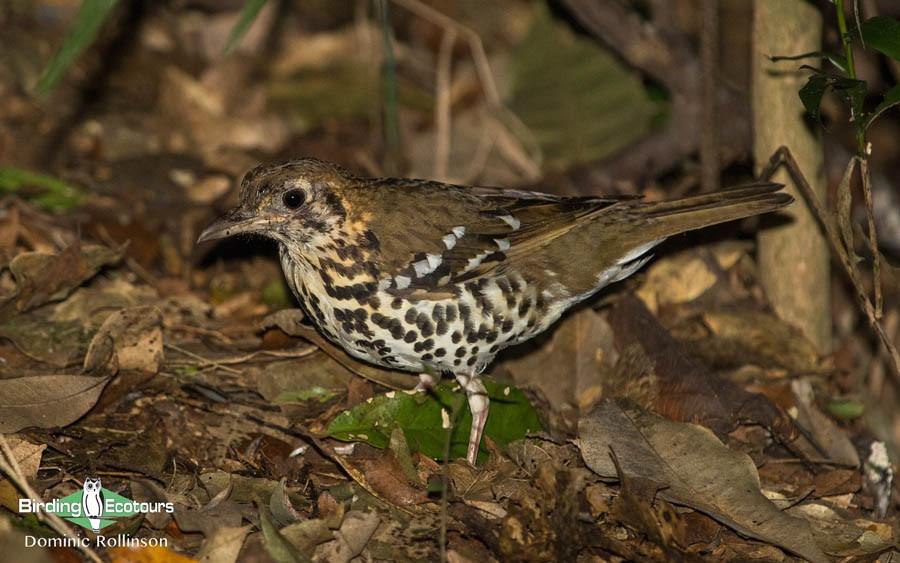
Dlinza forest is the only spot on this tour for the scarce Spotted Ground Thrush.
Returning to Mtunzini, we decided to bird a few spots in Umlalazi Nature Reserve south of town. Additions made to the trip list around the reserve included Purple-banded Sunbird, Yellow-breasted Apalis, African Paradise Flycatcher, Eastern Golden Weaver and, best of all, a pair of Green Malkohas. These secretive cuckoos really made us work for good views of them, but eventually we were rewarded for our efforts. What was supposed to be another brief stop at one of the parks in town turned out to be very fruitful, delivering a calling Scaly-throated Honeyguide, Red-chested Cuckoo and our best views of Narina Trogon. Our final stop in Mtunzini was the forests near the Raffia Palm Monument alongside Umlalazi. The main additions here were two flighty Blue-mantled Crested Flycatchers and a male Black-throated Wattle-eye.
Returning to Eshowe, we had enough time to pay a quick visit to the nearby Dlinza Forest. Despite the light rain, we once again scored a few new species, most notable of which were numbers of Lemon Dove and a single Tambourine Dove pottering around the hide next to reception. Seeing that many individuals of such a shy species was very special. After quick views of both Red-capped and Chorister Robin-Chats, we left Dlinza and made it back to our lodge, with enough time to relax before dinner, for once!
Day 6, 19th October 2024. Dlinza Forest, transfer to St Lucia
With gloomy weather looming over Eshowe this morning, we made an early start and birded the well-known Dlinza Forest on the outskirts of town. Upon entering the forest, we were greeted by a pair of incredibly confiding Narina Trogons. Given how hard we had to work the day before to get a good visual of this bird, this was a welcome sighting.The aerial boardwalk was rather quiet, with nothing but a few distant Black-bellied Starlings showing. Things didn’t get much easier down on the trails beneath the high canopy and grey skies. However, it also didn’t take long for us to find one of our main targets: a Spotted Ground Thrush, ironically, singing high in a tree. This is a key site in South Africa for this localized species.
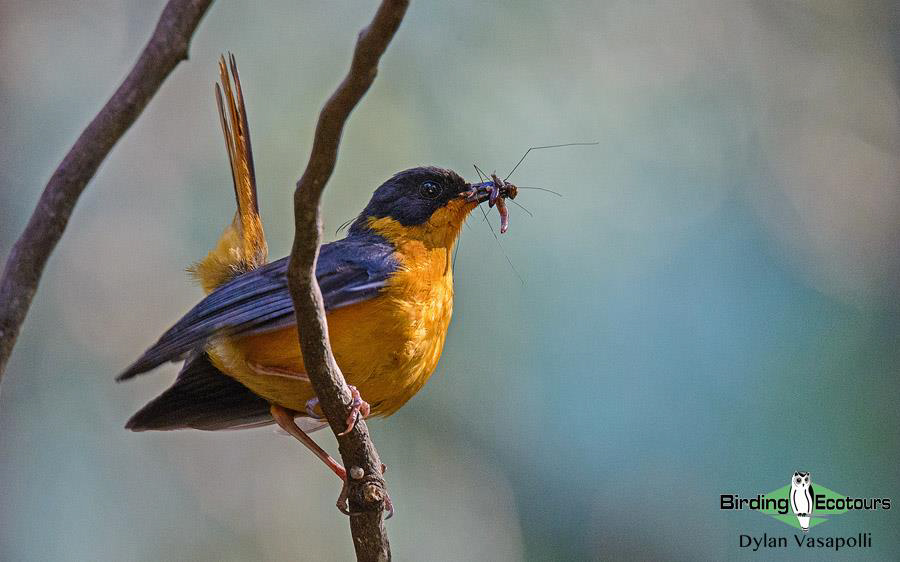
Chorister Robin-Chats were shy but common on the forest floor at Dlinza.
Continuing through the forest, we slowly started accumulating more species such as Olive Thrush, Chorister Robin-Chat, Terrestrial Brownbul and Cape Batis. Hearing another Scaly-throated Honeyguide making its strange call from its calling post was also noteworthy. Eventually, we struck gold when we stumbled into a bustling mixed species foraging party in an opening in the forest canopy. Here we quickly amassed a large number of species. Amidst the myriad of Collared Sunbirds, Cape White-eyes, Black-backed Puffbacks, Yellow-breasted Apalis and Chorister Robin-Chats, we managed to pick out an Olive Woodpecker, a couple of Olive Bushshrikes, a surprisingly showy Green Malkoha and, least expected of all, a Bush Blackcap. The latter is quite rare at this site. We only ended up hearing Grey Cuckooshrike and African Emerald Cuckoo, along with more species we’d already seen like Southern Boubou, Narina Trogon, Bar-throated Apalis, Sombre and Yellow-bellied Greenbul and Tambourine Dove. We also enjoyed a rather unbothered Blue Duiker feeding alongside the trail, a great opportunity to observe this shy antelope.
After paying another visit to the Lemon Doves at the hide near reception, we then left Dlinza and headed back to our accommodation for a lovely sit-down breakfast. We had great looks at a male Klaas’s Cuckoo and a Southern Grey-headed Sparrow,before checking out and making our way back towards Mtunzini. A young Lanner Falcon perched on a roadside telephone pole was a pleasant, albeit unexpected distraction. We stopped at a sugarcane field lying fallow just north of town, which played host to a breeding colony of about 40 Collared Pratincoles. We took the time to enjoy these elegant “waders” resting in the field and noisily flying around us, picking up a Kittlitz’s Plover with a chick in the process. The taller cane field next door delivered great views of Rufous-winged Cisticola, and a displaying Rufous-naped Lark. After our final addition at this spot in the form of a female Pin-tailed Whydah, we headed into town for lunch. A short drive down to the nearby Raphia Palm monument also got us great looks at a Burchell’s Coucal attempting to sun itself on a dead bush.
Lunchtime done, we arrived in St Lucia in the early evening, where we relaxed and were serenaded by Southern Crested Guineafowl before heading out to a fabulous dinner in town.
Day 7, 20th October 2024. Birding the Eastern Shores of the Isimangaliso Wetland Park
We had a slightly later start this morning to avoid the rain that had been predicted. Fortunately, it held out for most of the day and remained cloudy, yet comfortable. Our day started with good looks at Southern Crested Guineafowl, Red-capped Robin-Chat and Yellow-bellied Greenbul at our accommodation, before heading towards Bhangazi Gate. A brief stop at the bridge over the narrow section of the St Lucia estuary delivered a couple of male Southern Brown-throated Weavers chasing each other around the reeds. A few Common Swifts were seen flying high above the masses of Little Swifts that circled the bridge, and a male Diederik Cuckoo perched obligingly in a tree next to the carpark. We also had brief looks at Common Reed Warbler and Lesser Swamp Warbler, flyovers from Grey-headed Gull and Caspian Tern, and our first proper looks at African Pied Wagtail.

Almost every forest around Eshowe and Mtunzini delivered the gorgeous Narina Trogon.
Upon arriving at the gate, we were greeted by an African Goshawk circling high overhead, uttering its repetitive display call. We also got Crowned Hornbill and Black-collared Barbet around the gate, before heading off into the park. The first animals we saw as we entered the reserve were two Impala rams rutting half-heartedly. This was followed by a distant Black-chested Snake-Eagle sitting on a faraway tree. We then stopped at Amazibu hide, which overlooks a small wetland. Here we found Yellow-billed Egret, Lesser Masked Weaver, Croaking Cisticola, African Jacana, Reed Cormorant, Little Grebe, plenty of White-backed Ducks, a pair of White-faced Whistling Ducks and a male Rufous-bellied Heron (quite a rarity in South Africa). Another small pool a few meters down the road was just as productive, and provided point-blank views of Spur-winged Goose, White-backed Duck, another Rufous-bellied Heron (this one a female), Squacco Heron, Yellow-billed and Great Egret, Black-headed Heron, Eastern Golden Weaver, African Jacana and the jewel-like African Pygmy Kingfisher.
Continuing on through the park, we started picking up the first of many large game species, including Cape Buffalo, Plains Zebra, Blue Wildebeest and Waterbuck, while other small wetlands alongside the road added Malachite Kingfisher and Black Crake to the day list. Burchell’s Coucals were also quite a feature of the day, and we saw many perched out in the open after the erratic rain showers throughout the day. Rattling Cisticolas and Brown-hooded Kingfishers adorned the telephone lines, and Barn and Red-breasted Swallows were often seen flying low over the grasslands. The latter were particularly showy, often perching on low bushes alongside the road and singing their beautiful song. A distant flying raptor revealed itself to be an African Cuckoo-Hawk, while a larger one perched on a nearby telephone pole near the Mission Rocks turnoff, turned out to be the threatened Southern Banded Snake Eagle. We had stunning views of this rare raptor, and spent some time watching it sit sluggishly on its mid-morning vigil for snakes. Driving to and from our brunch stop at Mission Rocks, we had several sightings of tame Southern Crested Guineafowl next to the road. Watching their antics was quite entertaining, but they were quickly outdone by a beautiful African Cuckoo-Hawk perched near the roadside on the way out of Mission Rocks. This scarce raptor is not often encountered, let alone this well, so we once again took the time to admire this bird of prey as it preened itself, unbothered by the hordes of cameras firing away in its direction! We also had brief flyover views of two Livingstone’s Turacos, but the best views of this bird were still to come!
We pushed on towards Cape Vidal, picking up one or two Common Buzzards as we went and adding more mammals to the day list, including Greater Kudu, Southern Reedbuck, Southern Bushbuck, Bush Duiker and Warthog. Another addition to the growing list of close, perched raptor sightings was that of a young African Harrier-Hawk near Cape Vidal. As we descended into the coastal forest that surrounds Cape Vidal, we started noticing more Natal Red Duiker at the roadside, as well as one or two Blue Monkeys: a pleasant change from the ubiquitous Vervet Monkeys. Upon arrival at Cape Vidal, we took a stroll around the forests near the campgrounds, which delivered Trumpeter Hornbill, Blue-mantled Crested-Flycatcher, Terrestrial Brownbul, Sombre and Yellow-bellied Greenbul, Green-backed Camaroptera, Ashy Flycatcher, Southern Boubou and Golden-tailed Woodpecker. Above the curio shop, we managed to find a pair of Woodward’s Batis that showed very well. This range-restricted species can be quite shy and difficult to see well, so this was a noteworthy sighting. A large troop of Blue Monkeys also provided stellar views at this spot, including a partially leucistic baby that seemed golden brown in color! A sneaky African Goshawk would not be so obliging and only sat still for a second before fleeing from sight.
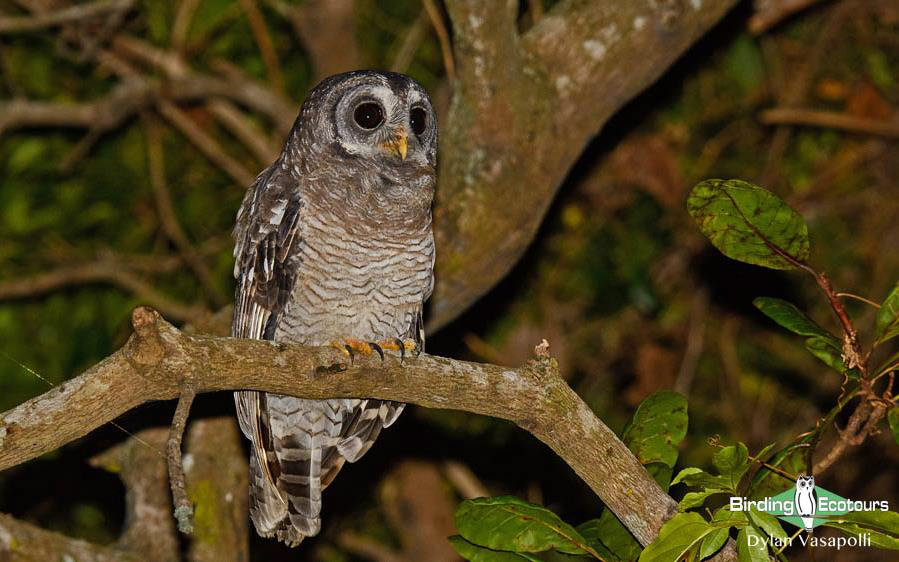
A pair of duetting African Wood Owls near our St Lucia accommodation was a surreal experience!
The drive back to St Lucia didn’t add a ton of new species, but we did get lovely views of two Little Bee-eaters sallying next to the road. A short foray down one of the dirt tracks in the reserve delivered a group of Collared Pratincoles roosting in the road (and not very willing to move, even for a motor vehicle!). They were also seen mobbing a distant African Marsh Harrier, while yet another Rufous-bellied Heron was seen flying in the opposite direction. A Pale-crowned Cisticola foraged at the road verge, while a Rufous-winged Cisticola provided more satisfactory views nearby. Other new day/trip species added along the main road included Black-collared Barbet, Yellow-throated Longclaw, Brimstone Canary, Scarlet-chested Sunbird, Spectacled Weaver, Western Cattle Egret and Red-billed Oxpecker (the latter two both seen sitting on buffalo!). The roadside pool near Amazibu hide added a Little Bittern and a stunning male African Pygmy Goose to the day list, before we left the park and headed into town for dinner. A final stop before returning home was at a nearby campsite where, in no time at all, we had brilliant views of a pair of African Wood Owls displaying above us. What a way to end a phenomenal day of birding in St Lucia!
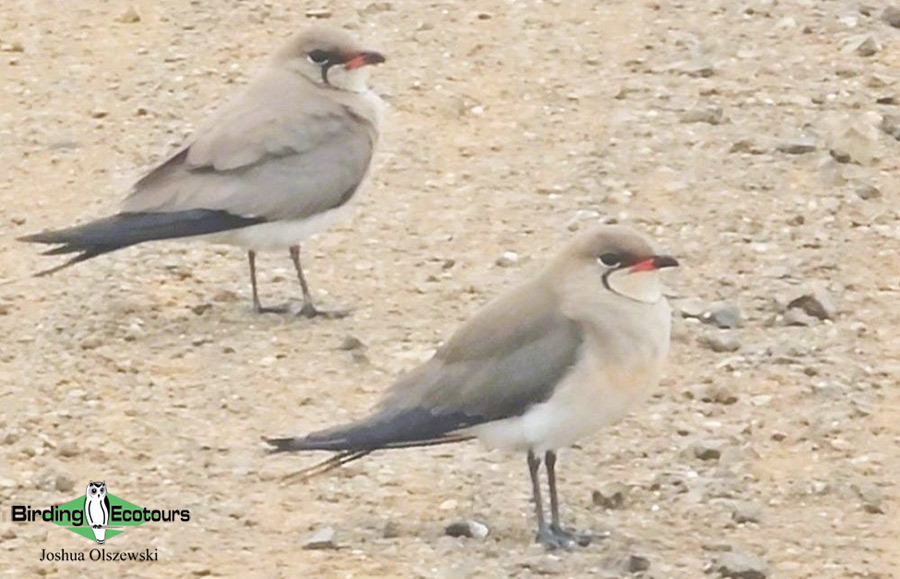
The elegant Collared Pratincole breeds alongside large pans and floodplains in Zululand during summer.
Day 8, 21st October 2024. Birding St Lucia, transfer to Hluhluwe
Our morning began by exploring the excellent iGwalagwala Trail running through the coastal forest around the town. The forest was alive with the calls of many of the afore-seen forest birds, while visual highlights included finally getting eyes on both Yellow-breasted and Rudd’s Apalis, a young Olive Bushshrike and a pair of Spectacled Weavers, while an African Goshawk displayed over canopy (lower down than yesterday’s one, too!). We got lucky when we heard a Buff-spotted Flufftail calling from a thicket next to the path. We decided to try coax it into view and were rewarded with brief views of the bird crossing the track in front of us. A Red Bush Squirrel foraging on a dead log was a great new mammal for the trip, and we managed to get eyes on yet another Green Malkoha,which turned out to be much showier than the previous ones.
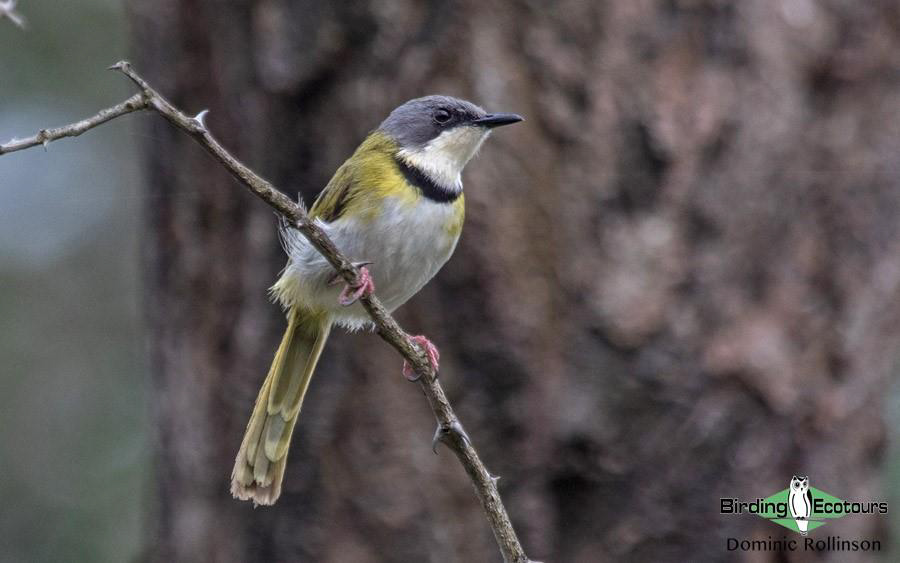
Although it is a localized, sand forest specialty, we had multiple great views of Rudd’s Apalis during our time in Zululand.
We then returned to the lodge for breakfast, after which we packed our bags and headed down to the St Lucia estuary mouth. Another group of Southern Crested Guineafowl and a female Thick-billed Weaver bid us farewell from our lodge as we made our way down to the estuary. The boardwalk down to the beach here delivered much better views of Black-throated Wattle-eye, while the adjacent reedbeds held Tawny-flanked Prinia, Lesser Swamp Warbler and Eastern Golden Weaver. The mouth itself held little of interest, but we managed to scratch out a small tern roost that consisted mostly of Caspian and Greater Crested Terns. Other birds seen included Grey Heron, Great Egret, Grey-headed Gull, Eurasian Whimbrel, Brimstone Canary and a distant pair of African Fish-Eagles. Heading back from the estuary into town, the lush forest along the road finally delivered the beautiful and desirable Livingstone’s Turaco, with two birds calling and showing superbly! Our first mousebird of the trip, a Speckled Mousebird, was also seen here, as was heard another Buff-spotted Flufftail. We then headed back into town for lunch, where the birding was surprisingly fruitful. We got great views of a male Scarlet-chested Sunbird, White-eared Barbet, a pair of Purple-crested Turacos and a mixed flock of Little, White-rumped and African Palm Swifts just around the restaurant!
After we had left St Lucia, we made our way north and lightly birded the dirt track that runs past Bonamanzi Game Reserve towards Hluhluwe. Bird life in the lush Acacia savanna here was bustling, and highlights included our first Wire-tailed Swallows, White-bellied Sunbird and Broad-billed Rollers of the trip, a dashing Orange-breasted Bushshrike, and herds of antelope that included Nyala, Impala and Southern Reedbuck. Lesser Striped Swallows landing on the road to collect mud for their nests was very special to see, and Lesser Masked Weaver, Village Weaver, Cape Starling, Southern Black Flycatcher, Black-winged and Yellow-billed Kite, and Red-billed Oxpecker were all seen along this road.
Upon reaching Kuleni Game Park and driving towards Umkhumbi Lodge, we had astonishing, eye-level views of a juvenile African Goshawk, while a walk around the lodge grounds after dinner revealed a calling Thick-tailed Greater Galago and a few interesting amphibians: Red Toad, Snoring Puddle Frog and Plain Grass Frog.
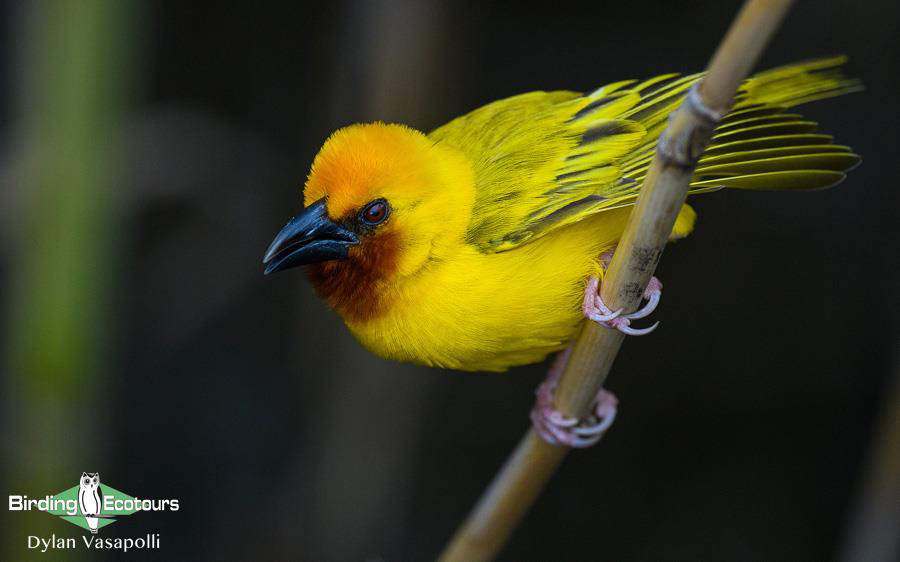
Weavers are plentiful in Zululand, and Southern Brown-throated Weaver was one of our targets while in the region.
Day 9, 22nd October 2024. Birding Muzi Pan and Mkhuze Game Reserve
With an early start we made our way out of Kuleni, being distracted by a stunning male Gorgeous Bushshrike, before heading in the direction of Mkuze Game Reserve. The dirt roads between Kuleni and the eastern gate of Mkuze were particularly bird-rich, and we started getting to grips with the plethora of savanna species that had become available to us. These included new trip species like Black-crowned Tchagra, European Bee-eater and Southern Masked Weaver. One stop in the hills just before the gate was especially productive and delivered Long-billed Crombec¸ Southern Red-fronted Tinkerbird, African Hoopoe, White-bellied Sunbird, Speckled Mousebird, Southern Black Tit, White-browed Scrub Robin and a stunning perched Jackal Buzzard.
After signing in at the gate, we took a break at the campsite just inside the park to have our breakfast and walk around. Exploring the camp grounds revealed a large number of species that showed quite well, such as Orange-breasted Bushshrike, Red-billed Oxpecker, Grey Tit-Flycatcher, Ashy Flycatcher, Southern Black Flycatcher, Mocking Cliff-Chat, Acacia Pied Barbet, Spectacled Weaver, Green Wood Hoopoe, Common Scimitarbill, Klaas’s Cuckoo, Red-chested Cuckoo, Kurrichane Thrush, Yellow-throated Bush Sparrow, Blue Waxbill, Yellow-breasted Apalis, Cardinal Woodpecker, Golden-tailed Woodpecker, Brown-crowned Tchagra, Scarlet-chested and Purple-banded Sunbirds and good numbers of Violet-backed Starlings amidst the ubiquitous Cape Starlings. Once the sun broke through the clouds, the humidity and heat shot up rapidly, and with that came lots of soaring raptors. Just over the campsite we had Black-chested and Brown Snake Eagle, a couple of White-backed Vultures, a beautiful low-flying Crowned Eagle and a Lanner Falcon that came stooping down at high speed, right into the campsite (in an attempt to catch the birds foraging around the car!). Both Barn and Lesser Striped Swallows were plentiful, with the latter landing at a small mud puddle near the camp entrance.
After we’d had our fill of the camp birding, we ventured into the park, finding a singing Sabota Lark, Striped Kingfisher, Tawny Eagle and even a local scarcity: a Dark Chanting Goshawk. We then arrived at Mantuma camp, where another brief walkabout got us good views of Little Bee-eater, Black Cuckooshrike, Brubru, Grey Waxbill and more mud-puddling Lesser Striped Swallows. We then headed to Kumasinga hide to have lunch and enjoy the wildlife surrounding the hide. The waterhole was full of Marsh Terrapins (some of which were eagerly waiting for lunch scraps below the hide!), while the shoreline played host to a number of bird species either bathing or coming to drink. This granted us to great views of Three-banded Plover, Blue Waxbill, Southern Grey-headed Sparrow, Yellow-fronted Canary, Emerald-spotted Wood Dove, Ring-necked Dove, Village and Lesser Masked Weaver and Sombre Greenbul. A Brown-hooded Kingfisher excavated a nest burrow in the bank across the water, while the neighboring flowering bushes delivered our first Marico Sunbird of the trip. A small group of Nyala came down to drink, with their resident fleet of Red-billed Oxpeckers, that also took the opportunity to have a drink. A Wahlberg’s Eagle swooping and soaring over the hide was a nice trip addition.
Driving out of the hide, we were greeted by a showy Crested Francolin and a less obliging Bearded Scrub Robin, both of which were making the most of a termite eruption that was happening along the track. Joining them were large numbers of African Bullfrog and Bushveld Rain Frog, the former needing to be escorted off the road due to their short legs and lack of self-preservation instincts! Avoiding the frogs, we were also treated to one or two Leopard Tortoises trodding along the main road. African Firefinch and another showy Sabota Lark were also seen along the main road. A distant roadside dam also revealed Waterbuck, Pied Kingfisher, Little Egret and Reed Cormorant. After leaving the park, we passed straight through a thunderstorm on our way back to Kuleni. However, there was a brief lull as we arrived at Muzi Pan, which got us Great White Pelican, White-faced Whistling Duck, Spur-winged Goose, Great Egret, African Jacana, Glossy Ibis, Little Grebe and a Goliath Heron. A few distant waders turned out to be Ruff and were the final additions of the day, before pushing through the rest of the thunderstorm (which was bucketing down quite hard in some places), and settling in for dinner by candlelight.
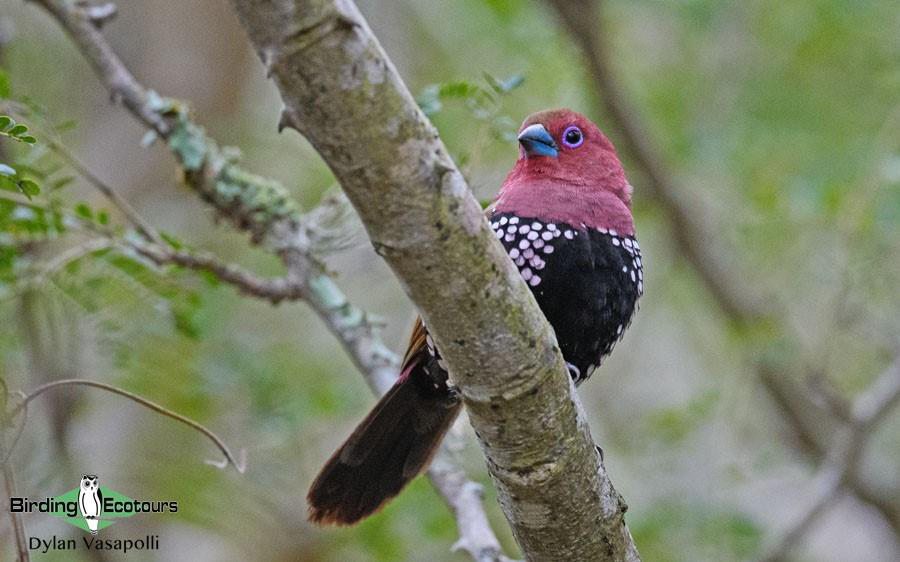
Like the Apalis, Pink-throated Twinspot is another delightful sand forest endemic that we saw beautifully at Kuleni..
Day 10, 23rd October 2024. Birding Hluhluwe and transfer to Wakkerstroom
We had an early morning walk around our lodge grounds this morning. Set amidst lush sand forest, the birding here was quite prolific, and within an hour and a half, we had amassed an impressive list of species. Notable mentions included Eastern Nicator, Pink-throated Twinspot, Gorgeous Bushshrike, Black Cuckoo, Bearded Scrub Robin, Rudd’s Apalis, Southern Red-fronted Tinkerbird, Narina Trogon, Grey Tit-Flycatcher and a number of sunbird species.
After breakfast, we headed north to Mpempe Pan, stopping enroute along a dirt track that skirts the fence line of Phinda Game Reserve. Here we picked up another Gorgeous Bushshrike and, best of all, a stunning male African Emerald Cuckoo perched low over the road!
After arriving at Mpempe, we managed to find a nesting pair of Senegal Lapwings, as well as a mixed flock of both Crowned and Black-winged Lapwings after a short search (and briefly getting stuck in the mud!). A pair of Spotted Thick-knees was another surprise find here. The air was full of flying termites, and large numbers of birds were flying around and gorging themselves on the sudden abundance of food. Most were Village Weavers and Barn Swallows, accompanied by smaller numbers of Thick-billed and Lesser Masked Weaver and Cape Starling. The ground was riddled with African Pipits and Southern Red Bishops that were doing the same, along with a couple of Zitting Cisticolas. In the distance we could see that the pan itself was full of waterbirds, and scanning quickly delivered White-faced Whistling Duck, Western Cattle and Little Egret, Purple Heron, African Jacana, Pied Kingfisher, African Darter and a flyby from two Pink-backed Pelicans.
Heading south again, we stopped at a great restaurant, near our accommodation, for lunch, enjoying the Eastern Striped Skinks that were catching termites on the lawns. After this we started on the long drive to Wakkerstroom. Not much birding was done during the drive, so we simply settled in and enjoyed the marvelous sunset over the rolling hills along our route, and then a delicious homecooked dinner at the guesthouse.
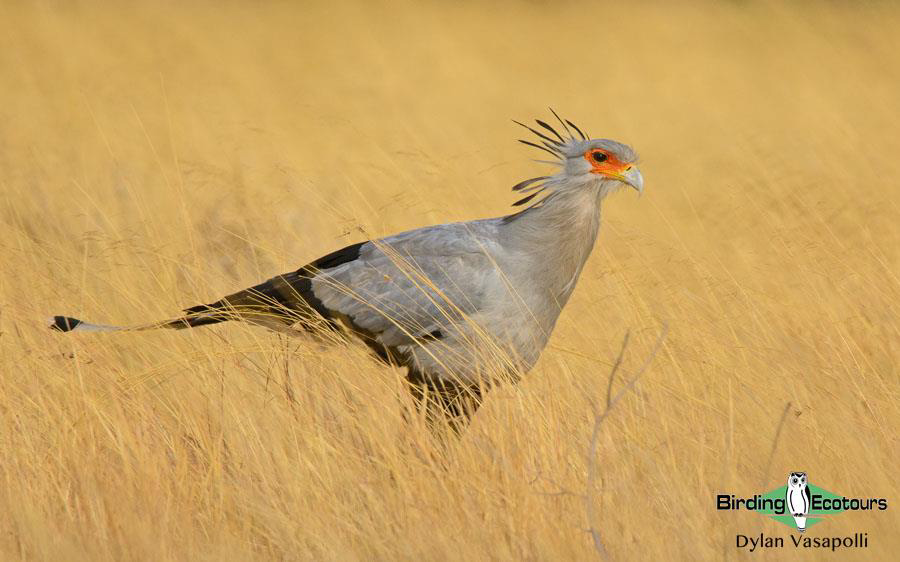
The bizarre Secretarybird was seen striding through the grasslands near Wakkerstroom town!
Day 11, 24th October 2024. Endemic birding around Wakkerstroom
We had a full day at our disposal for birding around Wakkerstroom, and were to make use of local guide, Lucky, for the day. Before heading out, we were treated to a feisty pair of Red-winged Francolins at our accommodation, running circles around us comically! After a flyby pair of Grey Crowned Cranes, we met up with Lucky and proceeded to bird the rolling green hills south of town. Birding in these high-altitude grasslands is very busy, and it was hard not to get distracted by the sheer abundance of birds and diversity of species! Magnificent Long-tailed Widowbirds were displaying everywhere, and the air was full of aerial feeders, mainly Greater Striped, White-throated and Barn Swallows and Banded, Brown-throated and Large Rock Martins. Other common birds in these grasslands included Cape Crow, Swainson’s Spurfowl, Crowned and Blacksmith Lapwings, Spur-winged Goose, Cape Longclaw, Cape and Pied Starling, African Pipit, Fan-tailed Widowbird, Red-capped Lark, Black-headed Heron, African Stonechat, Common Waxbill, and Wing-snapping, Zitting and Levaillant’s Cisticola. Isolated pools and farm dams along the roadside delivered African Spoonbill, Red-billed Teal, Cape Shoveler, Whiskered Tern, Red-billed Quelea, Southern Masked Weaver and Southern Red Bishop.
We made a stop on a rocky hillslope above the village of Groenvlei. Here we connected with Cape Canary, Cape Bunting, Mountain Chat and the endemic African Rock Pipit (a specialty of this habitat). Afterwards, we arrived at a nearby farm where, thanks to our guide, we were able to drive onto the property and ascend a picturesque grassy hill in search of our next targets. We parked atop the hill and walked around the fields for about two hours and ended up with a fantastic haul of species. The most noteworthy were a number of dazzling Yellow-breasted Pipits and, even rarer, a Rudd’s Lark. These two species are highly localized endemics of these high-altitude grasslands, and we were blessed to have gotten great views of both species. Numbers of Ant-eating Chats, Red-capped Larks and the charismatic Spike-heeled Lark made up the supporting cast, and a Blue Crane flyover was also enjoyable.
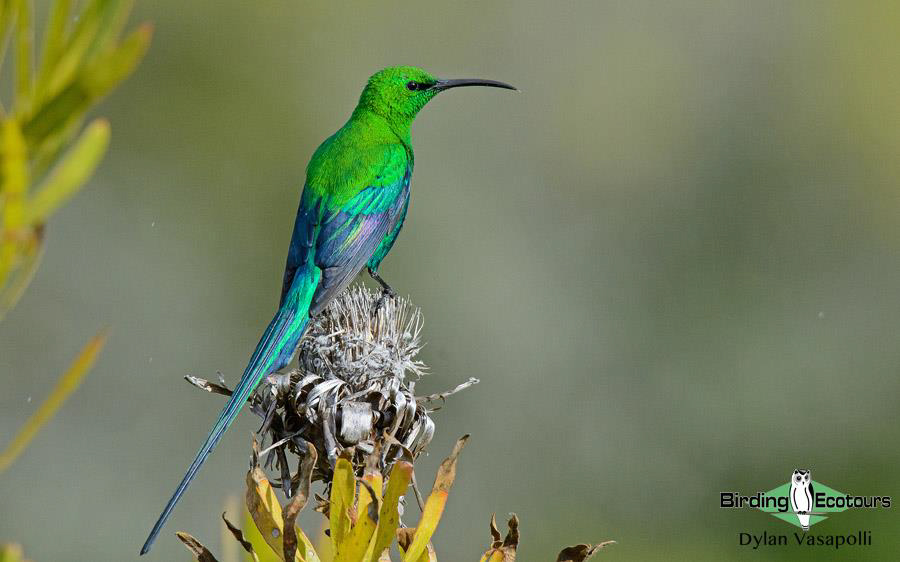
Among the greenest of all birds, the Malachite Sunbird is aptly named.
En route back to town, we made another stop on top of the hill above Wakkerstroom town. The rocky ground here gave us great views of Eastern Long-billed Lark, Mountain Chat, Buff-streaked Chat and another confiding pair of Red-winged Francolins. A Black Sparrowhawk diving on a Red-winged Starling above town was quite stunning. We then had lunch in town, after which we decided to head northeast towards the village of Dirkiesdorp. Various stops along the gravel backroads gave us a plethora of noteworthy sightings. These included the first bustards of the trip: first a male Black-bellied Bustard doing his strange popping display call next to the road. Next up was a trio of male Denham’s Bustards displaying on a distant hill, accompanied by a slightly closer female. Lastly, a pair of White-bellied Bustards (endemic subspecies barrowi) were trying their best to remain undetected by us, but ultimately failed! This route also gave us the bizarre Secretarybird and a breeding colony of South African Cliff Swallows under a small bridge. After some final great birds like Rock-loving Cisticola, Southern Bald Ibis, African Yellow Warbler, Quailfinch, Nicholson’s Pipit and African Black Swift, we made our way back to Wakkerstroom and said farewell to our fantastic guide, before returning home for another wonderful homecooked meal.

An Endangered, high-altitude grassland endemic, there’s lots to love about the handsome Yellow-breasted Pipit!
Day 12, 25th October 2024. Birding Wakkerstroom wetland, and transfer to the Kruger National Park
We made an early, pre-breakfast dash out into the grasslands to try clean up one or two species we had missed the previous day. The grasslands along the Amersfoort dirt road abounded with most of the afore-mentioned species, with the added splendor of two Blue Korhaans and a couple of pugnacious Pale-crowned Cisticolas. Targets secured, we made it back to the lodge in time for a splendid breakfast, before checking out and heading towards the bridge over the well-known Wakkerstroom wetland. This system of reedbeds, flooded grassland and open water hosts a variety of waterbird species, notable mentions we saw included Malachite Kingfisher, African Swamphen, Lesser Swamp Warbler and Little Rush Warbler.
After this, we left Wakkerstroom and started on the longest drive of the tour (6 hours) towards Kruger National Park. Not much new was seen along this drive, with South African Cliff Swallows, Common Buzzards and a single Long-crested Eagle being the only notable mentions. However, just before reaching the park at the grand Paul Kruger gate, we were treated to an immense Goliath Heron and two stately Saddle-billed Storks loafing along the Sabie River. Shortly after crossing through the gate into the park, our haste in reaching the camp was quickly halted by a pile of cars blocking the road. Knowing that this could only mean one thing, we rolled towards the crowd and swiftly realized what was causing the back-up: a Leopard lounging at eye-level next to the road. Only twenty minutes in the park and we had already bagged ourselves a big cat! We relished the sighting for as long as we could, before eventually arriving at Skukuza camp in time for dinner on the banks of the Sabie River. What a welcome to one of the best wildlife parks out there!
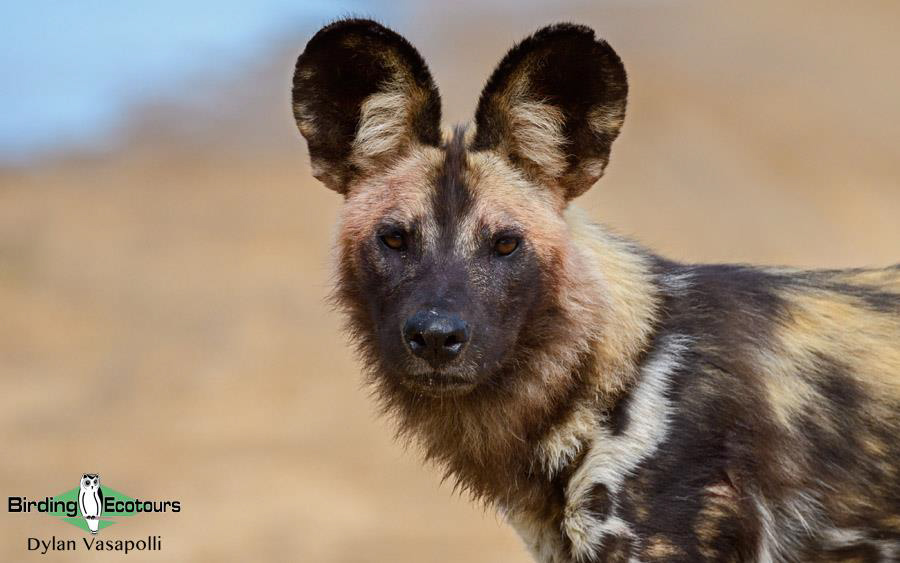
We managed to see the same pack of African Wild Dogs three times during our time in Kruger.
Day 13, 26th October 2024. Birding the famed Kruger National Park
Starting off our first full day in Kruger, the thickets around the camp were full of birds this morning, with the likes of Grey Go-away-bird, Black-collared Barbet, Black-headed Oriole, White-bellied Sunbird, Greater Blue-eared Starling, Blue Waxbill, Yellow-fronted Canary and African Hoopoe being quite common. We then piled into the safari vehicle and exited the camp gates into the park. Our excellent driver immediately took us to yet another Leopard that had been sighted along the same road we drove yesterday! This one was a bigger (and sleepier) individual than yesterday’s, so we left him in peace and proceeded towards Tshokwane picnic site. Common bushveld species along the drive included Emerald-spotted Wood Dove, Long-billed Crombec, Chinspot Batis, White-browed Scrub Robin, Yellow-breasted Apalis, Southern Black Tit, Black-backed Puffback, Orange-breasted Bushshrike, Rattling Cisticola, Fork-tailed Drongo, Tawny-flanked Prinia, Golden-breasted Bunting and Marico and White-bellied Sunbird. Such iconic safari birds as Magpie Shrike, Lilac-breasted Roller, African Grey Hornbill and Southern Yellow-billed Hornbill were also a feast for the eyes, as were the many blue starlings that seemed to cover the area. These were mostly Greater Blue-eared Starlings,but Cape Starling and the large Burchell’s Starling were also pretty common. The less colorful Wattled Starlings were less abundant but also around, as were Brown-crowned and Black-crowned Tchagra, Sabota Lark, Crested Barbet (pair seen excavating a nest hole), Cardinal Woodpecker and Black Cuckooshrike. Singletons of Levaillant’s Cuckoo, Cinnamon-breasted Bunting and a high-flying Black Stork were also great finds.
As we drove, we noticed lots of gamebirds along the roadside, which consisted of Helmeted Guineafowl, Crested Francolin and Natal and Swainson’s Spurfowl, while the bridge over the Sabie River delivered Grey Heron, Striated Heron, African Pied Wagtail, Wire-tailed Swallow, breeding Village and Lesser Masked Weavers, Common Hippopotamus and, best of all, four adorable Lion cubs! Kruger is as renowned for its abundance and diversity of raptor species as it is for its mammals. White-backed Vulture, Wahlberg’s and Tawny Eagle and the strangely shaped Bateleur were ever-present, with smaller numbers of African Fish Eagle, Brown Snake Eagle and Hooded Vulture also in evidence. On the note of big mammals, one of the top sightings of the day had to be a trio of female Lions taking down an Impala alongside the road in the Sabie riverbed. This was preceded by a family of African Wild Dogs trotting up the road right next to the car (a truly unforgettable sighting!). Other mammals seen included masses of African Savanna Elephant, Cape Buffalo, Impala, Southern Giraffe, Waterbuck, Plains Zebra, and smaller numbers of Nyala, Southern Bushbuck, Greater Kudu, Blue Wildebeest, Steenbok, Klipspringer, Common Warthog, Chacma Baboon, Smith’s Bush Squirrel, Common Dwarf Mongoose and Common Slender Mongoose.
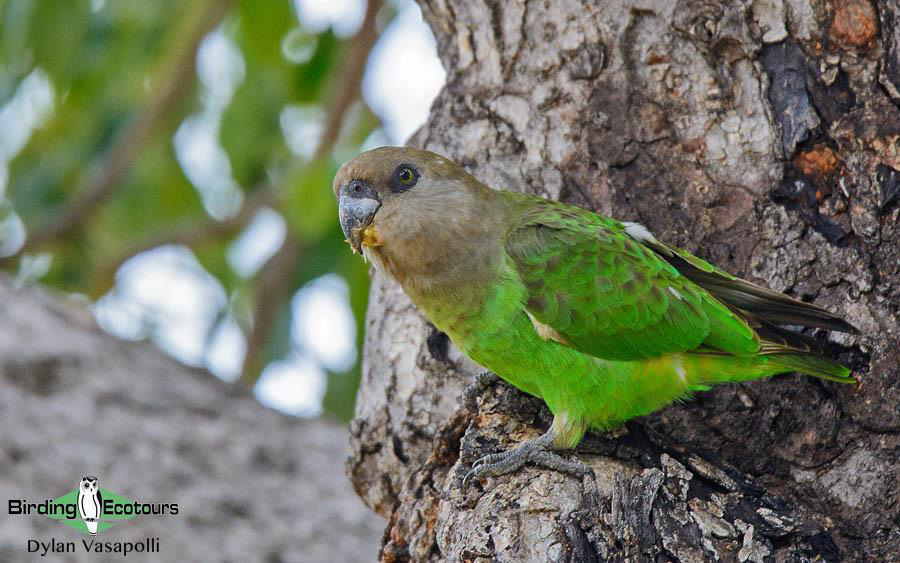
One of the few parrot species in South Africa, Brown-headed Parrot is a bird of savanna and riverine woodland.
Upon reaching Tshokwane, we had a scrumptious brunch at the deli, while being inundated with hungry Greater Blue-eared and Cape Starlings looking for scraps. These were accompanied by Laughing and Mourning Collared Doves (the latter a localized species in South Africa). We then walked around the picnic site where, after a bit of coaxing, we found a bustling mixed species foraging flock. These included a lot of the afore-mentioned species, with the addition of Green Wood Hoopoe, Common Scimitarbill, Brown-hooded Kingfisher, Common Reed Warbler, Spectacled Weaver, Terrestrial Brownbul, Arrow-marked Babbler, Scarlet-chested Sunbird and Kurrichane Thrush. Soon thereafter, the reason for all the chaos materialized, in the form of a Pearl-spotted Owlet, which provided stunning views before disappearing into the bush, taking its entourage of mobsters with it. Meanwhile, birding along the river in front of the picnic site delivered Red-faced Cisticola, African Paradise Flycatcher, Black, Crake, Black-winged Stilt, African Jacana, Wood and Common Sandpiper, Pied and Giant Kingfisher, Three-banded Plover and an overflying Sand Martin amidst the abundant Barn Swallows.
We then headed back towards Skukuza after brunch, adding a handful of great sightings and new species to the trip list. These included Purple Roller, Southern White-crowned Shrike, Grey-headed Bushshrike, White-fronted Bee-eater, Grey Penduline Tit, a flyby Shikra,two sightings of White-headed Vulture,a Common Hippopotamus walking out in broad daylight and a loafing White Rhinoceros near the camp gate (the latter completing our “Big 5 in one day” achievement). Arriving back at Skukuza in the late afternoon, we took the time to relax before dinner. The birding around the camp itself was enough to fill in the time, most notable were a singing African Goshawk, a flock of African Green Pigeons in a fruiting fig tree and a pair of African Black Ducks on the river in front of the restaurant. After dinner, most of the group went on a night drive which turned out to be quite rewarding. Over the two hour drive, we spotted a sleeping Leopard being harassed by a lone Spotted Hyena, the same group of African Wild Dogs that we had seen earlier (now snuggled up under a bush), two more groups of Spotted Hyena, two Rusty-spotted Genets, a Cape Porcupine, a Verreaux’s Eagle-Owl, a roosting Marabou Stork and, my personal highlight, a White-tailed Mongoose. This finished off an astounding day in Kruger, and probably my best day of game-viewing ever!
Day 13, 26th October 2024. Birding the famed Kruger National Park, part 2
On our second day of Kruger exploration, we decided to head south this time, towards Lower Sabie. Following the river for most of the day turned out to be a good call, as today turned out to be very hot and sunny, contrasting with the comfortable cloudy weather we had the previous day. Nonetheless, we made the most of it and ended up with an impressive species list for the day. We had seen most of these the previous day, but new additions included Purple Heron, Red-billed and Jameson’s Firefinch, Green-winged Pytilia, noisy Brown-headed Parrots,a single Mosque Swallow, a group of Retz’s Helmetshrike and, along the river, the handsome White-crowned Lapwing. Among the less common species seen, were Collared Pratincole (breeding on the river), Grey Tit-Flycatcher, Ashy Flycatcher, Trumpeter Hornbill, Spectacled Weaver, Hamerkop, Golden-tailed Woodpecker, African Woolly-necked and Saddle-billed Storks,and a surprise Cape Vulture. At one point we chanced upon a truly gargantuan herd of Cape Buffalo, at least 500 strong! Understandably, they were adorned with flocks of Red-billed Oxpeckers, which we saw on most of the big game in Kruger. However, upon careful inspection, we managed to pick out a handful of the scarcer Yellow-billed Oxpecker, not a common bird this far south.
We arrived at Lower Sabie just in time for lunch, once again overlooking the immense Sabie River. The respite from the heat was welcome, and we made sure to take our time and enjoy the vista from the restaurant deck. A nearby fountain attracted birds that were also seeking relief from the heat. These included White-browed Robin-Chat, Green-backed Camaroptera, Violet-backed Starling, Terrestrial Brownbul, African Paradise Flycatcher and Lesser Masked Weaver. Over the river, an African Fish Eagle gave us some close flybys, along with flocks of African Palm, Little and White-rumped Swifts and Lesser Striped Swallows. Once revitalized by our break, we left the camp and headed back towards Skukuza, stopping briefly at Sunset Dam on the way out of Lower Sabie. Here we found several waders, namely Wood, Common and Marsh Sandpipers, as well as White-fronted Bee-eater, African Openbill, Yellow-billed Stork and African Spoonbill. The rest of the journey back didn’t deliver much, but multiple close views of perched African Fish Eagles were enjoyed, as was another distant Lion pride. Once back at Skukuza, we bid farewell to our safari driver and relaxed for the rest of the evening, before having dinner and being serenaded by a pair of African Wood Owls from the camping area.

We had multiple Lion sightings during our two days in Kruger.
Day 15, 28th October 2024. Birding Skukuza and transfer to Dullstroom, birding en route
We had a more leisurely morning today, taking time for a birding stroll around camp, before having a sit-down breakfast at the restaurant. African Green Pigeon, Water Thick-knee, Great Egret, Purple-crested Turaco and a stunning Goliath Heron were all enjoyed along the river, while a Crowned Hornbill, two overflying Brown-headed Parrots and a brief Western House Martin were notable. After breakfast, we packed up (back into the tour van this time) and left Skukuza, heading south towards Malelane gate. Driving through the heat of the late morning, the birding was slow going, but we did manage to find our first Southern Red-billed Hornbills of the trip, as well as another Cinnamon-breasted Bunting and the uncommon Stierling’s Wren-Warbler. Once we crossed through Malelane gate, we stopped on the bridge over the Crocodile River where the birding was much more prolific. We had great views of many previously mentioned waterbirds, with the addition of a pair of African Skimmers roosting on the sandbars in the river. This iconic bird is a vagrant to South Africa but has been becoming more regular over the years and is now a rare annual breeder in places like Kruger. This pair has been returning for many years now. After enjoying the skimmers and two male Greater Honeyguides having a scuffle nearby, we left Kruger and set out on the long drive towards Dullstroom, leaving the hot, humid lowlands behind and once again ascending into the cool montane grasslands of the eastern interior of South Africa.
Day 16, 29th October 2024. Birding Dullstroom, and transfer to Dinokeng, birding en route
We decided to have a later start today and another leisurely morning, before heading towards our final destination of the tour. The birds around our chalets kept us entertained while we had our coffee, with Purple Heron, African Wattled Lapwing, Malachite Sunbird, Cape Weaver and a showy Bokmakierie all in evidence. Once we were packed up and on the road, we made our way back down the gravel access tracktowards the main road, where we witnessed large groups of African Olive Pigeons flying between the tree rows on the roadside farms. Streaky-headed Seedeater, Banded Martin, Cape Canary, European Bee-eater and Drakensberg Prinia were all seen before reaching the main tarred road. We then went into the quaint holiday town of Dullstroom, where we had yet another delicious sit-down breakfast and then made tracks west towards Pretoria and, ultimately, Dinokeng Game Reserve: our last base on the tour.
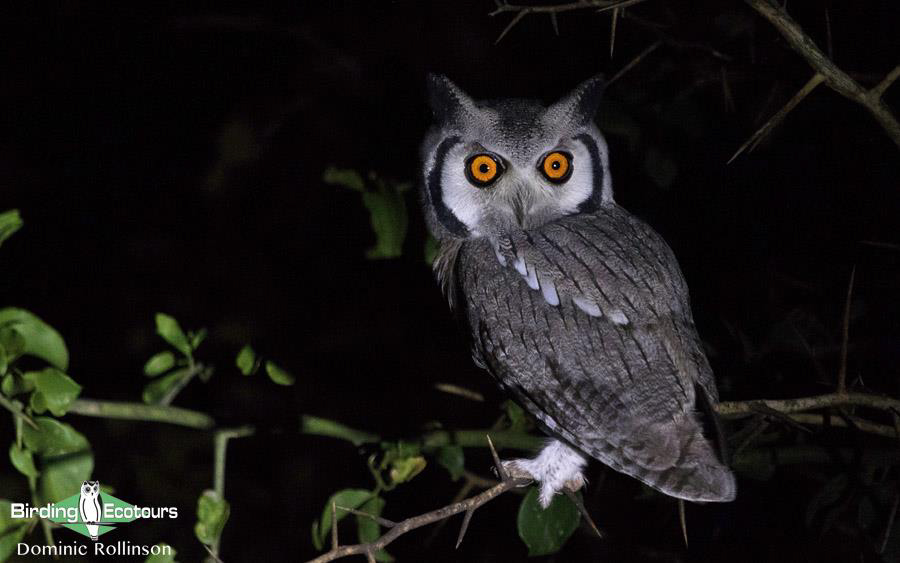
We managed to see two Southern White-faced Owls in Dinokeng, with others calling around us.
We arrived at our comfortable safari lodge in the afternoon. Set amidst mixed woodland and Acacia savanna, the birding in this region was quite reminiscent of Kruger, but with a noticeable influence from the Kalahari (much drier than Kruger). With the intense heat beating down on us once again, we took the rest of the afternoon off and enjoyed the bird activity around the lodge. From our lunch table we managed to see African Wattled Lapwing, Southern Red-billed and Southern Yellow-billed Hornbill, Burchell’s Starling, Groundscraper Thrush, Southern Black Flycatcher, Brubru, Willow Warbler, Golden-tailed and Cardinal Woodpecker and a fly-by Gabar Goshawk. After a lengthy period of relaxation and a hearty dinner, we went for a short night drive down one of the gravel roads north of the lodge. A few meters down the road and 45 minutes later, we had bagged at least two Southern White-faced Owls (more calling in the vicinity), as well as both Rufous-cheeked and Fiery-necked Nightjars. Add on a calling Pearl-spotted Owlet and this made for the best session of night birding on the whole tour!
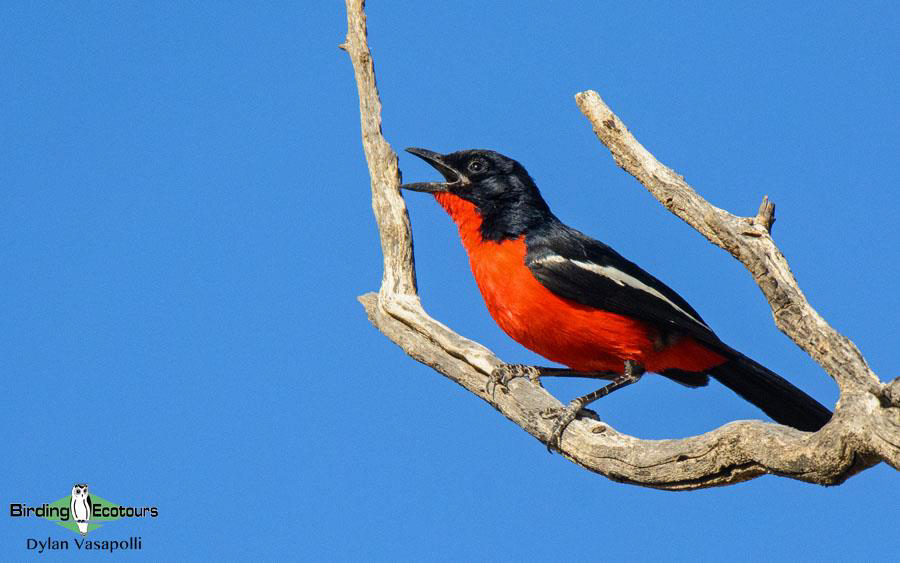
The bright and charismatic Crimson-breasted Shrike was among the last highlights of the tour.
Day 17, 30th October 2024. Birding the Zaagkuilsdrift Road and Kgomo-Kgomo
Our main objective this morning was to bird the famous 24-kilometer dirt road between the villages of Zaagkuilsdrift and Kgomo-Kgomo. This arbitrary track is well-known in local birding circles for the sheer abundance of species that can be found along it. The combination of dense Acacia thickets, short grassy plains and the nearby Pienaars River floodplain contribute to this diversity. The agricultural fields at the start of the track yielded several stunning Northern Black Korhaans, as well as Buffy Pipit. Shortly after this, the road entered the Acacia thickets which, as usual, were quite productive. It did not take long for us to start collecting some of the Kalahari specials found in this habitat, such as Black-chested Prinia, White-browed Sparrow-Weaver, Chestnut-vented Warbler, Southern Pied Babbler, Grey-backed Camaroptera and the vivid Crimson-breasted Shrike. Other Acacia-loving species seen along this first section of the road included Burnt-necked Eremomela, Blue Waxbill, Orange-breasted Bushshrike, Brubru, Burchell’s Starling, Green Wood Hoopoe, Southern Red-billed and Southern Yellow-billed Hornbill, Acacia Pied Barbet, White-bellied Sunbird, Crested Francolin, the ubiquitous Magpie Shrike and a trio of Red-billed Buffalo Weavers.
Further along, the thickets gave way to open grassy patches that were full of Crowned and African Wattled Lapwings, while the roadside game fence gave great views of a few Pearl-breasted Swallows, our final hirundine of the trip. An adorable Pearl-spotted Owlet showed quite well too, despite the mob of small birds harassing it! We also managed to pick out the near-endemic Marico Flycatcher from amongst the more common Spotted Flycatchers. By mid-morning it was already unbearably hot, so we decided to cut our losses and head straight to the western end of the road at Kgomo-Kgomo. Here, the flats surrounding the dry floodplain played host to a few handsome Capped Wheatears, while the scrub surrounding the adjacent village got us a Jacobin Cuckoo, the miniscule Cape Penduline Tit and a singing Barred Wren-Warbler. With our final handful of species in the bag, we departed from Kgomo-Kgomo and headed back towards our lodge in Dinokeng, but not without some lovely Namaqua Doves on the telephone lines to distract us.
Once again, we spent the rest of the scorching afternoon at the lodge, with plenty of bird activity to keep us entertained. A tame party of Arrow-marked Babblers was a notable addition to yesterday’s entourage of species, and we even managed to call in a Yellow-fronted Tinkerbird while having lunch. We did end up taking a short drive to Fischer Dam next to the lodge, which gave us more good views of afore-mentioned species, such as Golden-tailed Woodpecker, Burchell’s Coucal, Lesser Striped and White-throated Swallow, African Darter, Reed Cormorant, African Jacana and Great Egret.
Day 18, 31st October 2024. Birding urban Gauteng, and departure from Johannesburg
For the final morning of the tour, we once again had a later start and enjoyed a sit-down breakfast while continuing to enjoy the birds on the lodge grounds. Kurrichane Thrush, Red-headed Weaver, Marico Sunbird, Neddicky and Burnt-necked Eremomela were some of the notable mentions. After breakfast, we packed up the van for the last time and left the lodge. Before we left the reserve however, we did manage to connect with a showy Kalahari Scrub Robin and got brief views of a Red-crested Korhaan. Once we had left the reserve, we made a beeline for Johannesburg, with stops for lunch and a midday birding break at two different pans on the city outskirts. The first one was at Korsman Bird Sanctuary, where we finally managed to find flamingos! Both Greater and Lesser Flamingos were on show here, as well as Southern Pochard,amongst the more common waterbird species. The second pan, known as Bullfrog Pan, turned up some distant Maccoa Ducks,a close-by Blue-billed Teal and more Southern Pochards,while a male Diederik Cuckoo and a group of Green Wood Hoopoes rang out from the adjacent gardens. These would be our last new species for the trip, after which we settled down for one final lunch together as a group. We then made our way to the OR Tambo International Airport in Johannesburg, where the tour concluded.
Many thanks to all the tour participants for making this another unforgettable Subtropical South Africa Tour! With over 400 species seen and a plethora of good mammals, this tour was definitely one to remember.
Bird List – Following IOC Version 15.1 (February 2025)
Birds ‘heard only’ are marked with (H) after the common name, all other species were seen.
The following notation after species names is used to show conservation status following the IUCN Red List:
CR = Critically Endangered, EN = Endangered, VU = Vulnerable.
| Common name | Scientific name |
| Ostriches (Struthionidae) | |
| Common Ostrich | Struthio camelus |
| Ducks, Geese, Swans (Anatidae) | |
| White-faced Whistling Duck | Dendrocygna viduata |
| Fulvous Whistling Duck | Dendrocygna bicolor |
| White-backed Duck | Thalassornis leuconotus |
| Spur-winged Goose | Plectropterus gambensis |
| Egyptian Goose | Alopochen aegyptiaca |
| South African Shelduck | Tadorna cana |
| African Pygmy Goose | Nettapus auritus |
| Blue-billed Teal | Spatula hottentota |
| Cape Shoveler | Spatula smithii |
| African Black Duck | Anas sparsa |
| Yellow-billed Duck | Anas undulata |
| Red-billed Teal | Anas erythrorhyncha |
| Southern Pochard | Netta erythrophthalma |
| Maccoa Duck – EN | Oxyura maccoa |
| Guineafowl (Numididae) | |
| Helmeted Guineafowl | Numida meleagris |
| Southern Crested Guineafowl | Guttera edouardi |
| Pheasants & Allies (Phasianidae) | |
| Crested Francolin | Ortygornis sephaena |
| Red-winged Francolin | Scleroptila levaillantii |
| Grey-winged Francolin | Scleroptila afra |
| Natal Spurfowl | Pternistis natalensis |
| Swainson’s Spurfowl | Pternistis swainsonii |
| Nightjars (Caprimulgidae) | |
| Rufous-cheeked Nightjar | Caprimulgus rufigena |
| Fiery-necked Nightjar | Caprimulgus pectoralis |
| Swifts (Apodidae) | |
| African Palm Swift | Cypsiurus parvus |
| Alpine Swift | Tachymarptis melba |
| African Black Swift | Apus barbatus |
| Little Swift | Apus affinis |
| White-rumped Swift | Apus caffer |
| Turacos (Musophagidae) | |
| Grey Go-away-bird | Crinifer concolor |
| Purple-crested Turaco | Gallirex porphyreolophus |
| Livingstone’s Turaco | Tauraco livingstonii |
| Knysna Turaco (H) | Tauraco corythaix |
| Bustards (Otididae) | |
| Denham’s Bustard | Neotis denhami |
| White-bellied Bustard | Eupodotis senegalensis |
| Blue Korhaan | Eupodotis caerulescens |
| Red-crested Korhaan (H) | Lophotis ruficrista |
| Northern Black Korhaan | Afrotis afraoides |
| Black-bellied Bustard | Lissotis melanogaster |
| Cuckoos (Cuculidae) | |
| Burchell’s Coucal | Centropus burchellii |
| Green Malkoha | Ceuthmochares australis |
| Great Spotted Cuckoo (H) | Clamator glandarius |
| Levaillant’s Cuckoo | Clamator levaillantii |
| Jacobin Cuckoo | Clamator jacobinus |
| Diederik Cuckoo | Chrysococcyx caprius |
| Klaas’s Cuckoo | Chrysococcyx klaas |
| African Emerald Cuckoo | Chrysococcyx cupreus |
| Black Cuckoo | Cuculus clamosus |
| Red-chested Cuckoo | Cuculus solitarius |
| Pigeons, Doves (Columbidae) | |
| Rock Dove | Columba livia |
| Speckled Pigeon | Columba guinea |
| African Olive Pigeon | Columba arquatrix |
| Lemon Dove | Columba larvata |
| Mourning Collared Dove | Streptopelia decipiens |
| Red-eyed Dove | Streptopelia semitorquata |
| Ring-necked Dove | Streptopelia capicola |
| Laughing Dove | Spilopelia senegalensis |
| Emerald-spotted Wood Dove | Turtur chalcospilos |
| Tambourine Dove | Turtur tympanistria |
| Namaqua Dove | Oena capensis |
| African Green Pigeon | Treron calvus |
| Flufftails & Forest Rails (Sarothruridae) | |
| Buff-spotted Flufftail (H) | Sarothrura elegans |
| Rails, Crakes & Coots (Rallidae) | |
| Common Moorhen | Gallinula chloropus |
| Red-knobbed Coot | Fulica cristata |
| African Swamphen | Porphyrio madagascariensis |
| Black Crake | Zapornia flavirostra |
| Cranes (Gruidae) | |
| Grey Crowned Crane – EN | Balearica regulorum |
| Wattled Crane – VU | Grus carunculata |
| Blue Crane – VU | Grus paradisea |
| Grebes (Podicipedidae) | |
| Little Grebe | Tachybaptus ruficollis |
| Flamingos (Phoenicopteridae) | |
| Greater Flamingo | Phoenicopterus roseus |
| Lesser Flamingo | Phoeniconaias minor |
| Stone-curlews, Thick-knees (Burhinidae) | |
| Spotted Thick-knee | Burhinus capensis |
| Water Thick-knee | Burhinus vermiculatus |
| Oystercatchers (Haematopodidae) | |
| African Oystercatcher | Haematopus moquini |
| Stilts, Avocets (Recurvirostridae) | |
| Black-winged Stilt | Himantopus himantopus |
| Pied Avocet | Recurvirostra avosetta |
| Plovers (Charadriidae) | |
| Grey Plover | Pluvialis squatarola |
| Common Ringed Plover | Charadrius hiaticula |
| Three-banded Plover | Charadrius tricollaris |
| Blacksmith Lapwing | Vanellus armatus |
| White-crowned Lapwing | Vanellus albiceps |
| Senegal Lapwing | Vanellus lugubris |
| Black-winged Lapwing | Vanellus melanopterus |
| Crowned Lapwing | Vanellus coronatus |
| African Wattled Lapwing | Vanellus senegallus |
| Kittlitz’s Plover | Anarhynchus pecuarius |
| White-fronted Plover | Anarhynchus marginatus |
| Jacanas (Jacanidae) | |
| African Jacana | Actophilornis africanus |
| Sandpipers, Snipes (Scolopacidae) | |
| Eurasian Whimbrel | Numenius phaeopus |
| Common Sandpiper | Actitis hypoleucos |
| Marsh Sandpiper | Tringa stagnatilis |
| Wood Sandpiper | Tringa glareola |
| Common Greenshank | Tringa nebularia |
| Ruff | Calidris pugnax |
| Little Stint | Calidris minuta |
| Coursers, Pratincoles (Glareolidae) | |
| Collared Pratincole | Glareola pratincola |
| Gulls, Terns, Skimmers (Laridae) | |
| African Skimmer | Rynchops flavirostris |
| Caspian Tern | Hydroprogne caspia |
| Common Tern | Sterna hirundo |
| Whiskered Tern | Chlidonias hybrida |
| Greater Crested Tern | Thalasseus bergii |
| Grey-headed Gull | Chroicocephalus cirrocephalus |
| Storks (Ciconiidae) | |
| African Openbill | Anastomus lamelligerus |
| Marabou Stork | Leptoptilos crumenifer |
| Yellow-billed Stork | Mycteria ibis |
| Saddle-billed Stork | Ephippiorhynchus senegalensis |
| African Woolly-necked Stork | Ciconia microscelis |
| Black Stork | Ciconia nigra |
| Anhingas, Darters (Anhingidae) | |
| African Darter | Anhinga rufa |
| Cormorants, Shags (Phalacrocoracidae) | |
| Reed Cormorant | Microcarbo africanus |
| White-breasted Cormorant | Phalacrocorax lucidus |
| Ibises, Spoonbills (Threskiornithidae) | |
| African Sacred Ibis | Threskiornis aethiopicus |
| Southern Bald Ibis – VU | Geronticus calvus |
| Hadada Ibis | Bostrychia hagedash |
| Glossy Ibis | Plegadis falcinellus |
| African Spoonbill | Platalea alba |
| Herons, Bitterns (Ardeidae) | |
| Little Bittern | Ixobrychus minutus |
| Black-crowned Night Heron | Nycticorax nycticorax |
| Black Heron | Egretta ardesiaca |
| Little Egret | Egretta garzetta |
| Little Heron | Butorides atricapilla |
| Rufous-bellied Heron | Ardeola rufiventris |
| Squacco Heron | Ardeola ralloides |
| Great Egret | Ardea alba |
| Yellow-billed Egret | Ardea brachyrhyncha |
| Western Cattle Egret | Bubulcus ibis |
| Grey Heron | Ardea cinerea |
| Purple Heron | Ardea purpurea |
| Black-headed Heron | Ardea melanocephala |
| Goliath Heron | Ardea goliath |
| Hamerkop (Scopidae) | |
| Hamerkop | Scopus umbretta |
| Pelicans (Pelecanidae) | |
| Great White Pelican | Pelecanus onocrolatus |
| Pink-backed Pelican | Pelecanus rufescens |
| Secretarybird (Sagittariidae) | |
| Secretarybird – EN | Sagittarius serpentarius |
| Kites, Hawks, Eagles (Accipitridae) | |
| Black-winged Kite | Elanus caeruleus |
| African Harrier-Hawk | Polyboroides typus |
| Palm-nut Vulture | Gypohierax angolensis |
| Bearded Vulture | Gypaetus barbatus |
| African Cuckoo-Hawk | Aviceda cuculoides |
| Hooded Vulture – CR | Necrosyrtes monachus |
| White-backed Vulture – CR | Gyps africanus |
| Cape Vulture – VU | Gyps coprotheres |
| White-headed Vulture – CR | Trigonoceps occipitalis |
| Black-chested Snake Eagle | Circaetus pectoralis |
| Brown Snake Eagle | Circaetus cinereus |
| Southern Banded Snake Eagle | Circaetus fasciolatus |
| Bateleur – EN | Terathopius ecaudatus |
| Crowned Eagle | Stephanoaetus coronatus |
| Martial Eagle – EN | Polemaetus bellicosus |
| Long-crested Eagle | Lophaetus occipitalis |
| Wahlberg’s Eagle | Hieraaetus wahlbergi |
| Tawny Eagle – VU | Aquila rapax |
| Verreaux’s Eagle | Aquila verreauxii |
| Gabar Goshawk | Micronisus gabar |
| Dark Chanting Goshawk | Melierax metabates |
| African Goshawk | Aerospiza tachiro |
| Shikra | Tachyspiza tachiro |
| Black Sparrowhawk | Astur melanoleucus |
| African Marsh Harrier | Circus ranivorus |
| Yellow-billed Kite | Milvus aegyptius |
| African Fish Eagle | Icthyophaga vocifer |
| Common Buzzard | Buteo buteo |
| Jackal Buzzard | Buteo rufofuscus |
| Owls (Strigidae) | |
| Pearl-spotted Owlet | Glaucidium perlatum |
| African Scops-Owl (H) | Otus senegalensis |
| Southern White-faced Owl | Ptilopsis granti |
| Spotted Eagle-Owl | Bubo africanus |
| Verreaux’s Eagle-Owl | Ketupa lactea |
| African Wood Owl | Strix woodfordii |
| Mousebirds (Coliidae) | |
| Speckled Mousebird | Colius striatus |
| Red-faced Mousebird | Urocolius indicus |
| Trogons (Trogonidae) | |
| Narina Trogon | Apaloderma narina |
| Hoopoes (Upupidae) | |
| African Hoopoe | Upupa africana |
| Wood Hoopoes (Phoeniculidae) | |
| Green Wood Hoopoe | Phoeniculus purpureus |
| Common Scimitarbill | Rhinopomastus cyanomelas |
| Hornbills (Bucerotidae) | |
| Southern Red-billed Hornbill | Tockus rufirostris |
| Southern Yellow-billed Hornbill | Tockus leucomelas |
| Crowned Hornbill | Lophoceros alboterminatus |
| African Grey Hornbill | Lophoceros nasutus |
| Trumpeter Hornbill | Bycanistes bucinator |
| Rollers (Coraciidae) | |
| Purple Roller | Coracias naevius |
| Lilac-breasted Roller | Coracias caudatus |
| Broad-billed Roller | Eurystomus glaucurus |
| Kingfishers (Alcedinidae) | |
| Brown-hooded Kingfisher | Halcyon albiventris |
| Striped Kingfisher | Halcyon chelicuti |
| African Pygmy Kingfisher | Ispidina picta |
| Malachite Kingfisher | Corythornis cristatus |
| Giant Kingfisher | Megaceryle maxima |
| Pied Kingfisher | Ceryle rudis |
| Bee-eaters (Meropidae) | |
| Little Bee-eater | Merops pusillus |
| White-fronted Bee-eater | Merops bullockoides |
| European Bee-eater | Merops apiaster |
| African Barbets (Lybiidae) | |
| Crested Barbet | Trachyphonus vaillantii |
| Green Barbet | Stactolaema olivacea |
| White-eared Barbet | Stactolaema leucotis |
| Yellow-rumped Tinkerbird | Pogoniulus bilineatus |
| Southern Red-fronted Tinkerbird | Pogoniulus pusillus |
| Yellow-fronted Tinkerbird | Pogoniulus chrysoconus |
| Acacia Pied Barbet | Tricholaema leucomelas |
| Black-collared Barbet | Lybius torquatus |
| Honeyguides (Indicatoridae) | |
| Lesser Honeyguide | Indicator minor |
| Scaly-throated Honeyguide | Indicator variegatus |
| Greater Honeyguide | Indicator indicator |
| Woodpeckers (Picidae) | |
| Red-throated Wryneck | Jynx ruficollis |
| Ground Woodpecker | Geocolaptes olivaceus |
| Golden-tailed Woodpecker | Campethera abingoni |
| Cardinal Woodpecker | Dendropicos fuscescens |
| Olive Woodpecker | Dendropicos griseocephalus |
| Caracaras, Falcons (Falconidae) | |
| Rock Kestrel | Falco rupicolus |
| Lanner Falcon | Falco biarmicus |
| African & New World Parrots (Psittacidae) | |
| Brown-headed Parrot | Poicephalus cryptoxanthus |
| Wattle-eyes, Batises (Platysteiridae) | |
| Cape Batis | Batis capensis |
| Woodwards’ Batis | Batis fratrum |
| Chinspot Batis | Batis molitor |
| Black-throated Wattle-eye | Platysteira peltata |
| Bushshrikes (Malaconotidae) | |
| Grey-headed Bushshrike | Malaconotus blanchoti |
| Olive Bushshrike | Chlorophoneus olivaceus |
| Orange-breasted Bushshrike | Chlorophoneus sulfureopectus |
| Gorgeous Bushshrike | Telophorus viridis |
| Bokmakierie | Telophorus zeylonus |
| Brown-crowned Tchagra | Tchagra australis |
| Southern Tchagra | Tchagra tchagra |
| Black-crowned Tchagra | Tchagra senegalus |
| Black-backed Puffback | Dryoscopus cubla |
| Southern Boubou | Laniarius ferrugineus |
| Crimson-breasted Shrike | Laniarius atrococcineus |
| Brubru | Nilaus afer |
| Vangas & Allies (Vangidae) | |
| Retz’s Helmetshrike | Prionops retzii |
| Cuckooshrikes (Campephagidae) | |
| Grey Cuckooshrike | Ceblepyris caesius |
| Black Cuckooshrike | Campephaga flava |
| Figbirds, Old World Orioles, Piopios (Oriolidae) | |
| Black-headed Oriole | Oriolus larvatus |
| Drongos (Dicruridae) | |
| Fork-tailed Drongo | Dicrurus adsimilis |
| Square-tailed Drongo | Dicrurus ludwigii |
| Monarchs (Monarchidae) | |
| Blue-mantled Crested Flycatcher | Trochocercus cyanomelas |
| African Paradise Flycatcher | Terpsiphone viridis |
| Shrikes (Laniidae) | |
| Southern White-crowned Shrike | Eurocephalus anguitimens |
| Magpie Shrike | Lanius melanoleucus |
| Southern Fiscal | Lanius collaris |
| Crows, Jays (Corvidae) | |
| Cape Crow | Corvus capensis |
| Pied Crow | Corvus albus |
| White-necked Raven | Corvus albicollis |
| Rockjumpers (Chaetopidae) | |
| Drakensberg Rockjumper | Chaetops aurantius |
| Fairy Flycatchers (Stenostiridae) | |
| Fairy Flycatcher | Stenostira scita |
| Tits, Chickadees (Paridae) | |
| Southern Black Tit | Melaniparus niger |
| Penduline Tits (Remizidae) | |
| Grey Penduline Tit | Anthoscopus caroli |
| Cape Penduline Tit | Anthoscopus minutus |
| Nicators (Nicatoridae) | |
| Eastern Nicator | Nicator gularis |
| Larks (Alaudidae) | |
| Spike-heeled Lark | Chersomanes albofasciata |
| Eastern Long-billed Lark | Certhilauda semitorquata |
| Sabota Lark | Calendulauda sabota |
| Rudd’s Lark – EN | Heteromirafra ruddi |
| Rufous-naped Lark | Mirafra africana |
| Large-billed Lark | Galerida magnirostris |
| Red-capped Lark | Calandrella cinerea |
| Bulbuls (Pycnonotidae) | |
| Sombre Greenbul | Andropadus importunus |
| Yellow-bellied Greenbul | Chlorocichla flaviventris |
| Terrestrial Brownbul | Phyllastrephus terrestris |
| Yellow-streaked Greenbul | Phyllastrephus flavostriatus |
| Dark-capped Bulbul | Pycnonotus tricolor |
| Swallows, Martins (Hirundinidae) | |
| Black Saw-wing | Psalidoprocne pristoptera |
| Banded Martin | Neophedina cincta |
| Brown-throated Martin | Riparia paludicola |
| Large Rock Martin | Ptyonoprogne fuligula |
| Blue Swallow – VU | Hirundo atrocaerulea |
| Pearl-breasted Swallow | Hirundo dimidiata |
| Barn Swallow | Hirundo rustica |
| White-throated Swallow | Hirundo albigularis |
| Wire-tailed Swallow | Hirundo smithii |
| Western House Martin | Delichon urbicum |
| Greater Striped Swallow | Cecropis cucullata |
| Lesser Striped Swallow | Cecropis abyssinica |
| Red-breasted Swallow | Cecropis semirufa |
| Mosque Swallow | Cecropis senegalensis |
| South African Cliff Swallow | Petrochelidon spilodera |
| Crombecs, African Warblers (Macrosphenidae) | |
| Cape Grassbird | Sphenoeacus afer |
| Long-billed Crombec | Sylvietta rufescens |
| Leaf Warblers (Phylloscopidae) | |
| Willow Warbler | Phylloscopus trochilus |
| Reed Warblers & Allies (Acrocephalidae) | |
| Lesser Swamp Warbler | Acrocephalus gracilirostris |
| Common Reed Warbler | Acrocephalus scirpaceus |
| African Yellow Warbler | Iduna natalensis |
| Grassbirds & Allies (Locustellidae) | |
| Barratt’s Warbler | Bradypterus barratti |
| Little Rush Warbler | Bradypterus baboecala |
| Cisticolas & Allies (Cisticolidae) | |
| Red-faced Cisticola | Cisticola erythrops |
| Lazy Cisticola | Cisticola aberrans |
| Rattling Cisticola | Cisticola chiniana |
| Wailing Cisticola | Cisticola lais |
| Rufous-winged Cisticola | Cisticola galactotes |
| Levaillant’s Cisticola | Cisticola tinniens |
| Croaking Cisticola | Cisticola natalensis |
| Neddicky | Cisticola fulvicapilla |
| Zitting Cisticola | Cisticola juncidis |
| Pale-crowned Cisticola | Cisticola cinnamomeus |
| Wing-snapping Cisticola | Cisticola ayresii |
| Tawny-flanked Prinia | Prinia subflava |
| Black-chested Prinia | Prinia flavicans |
| Karoo Prinia | Prinia maculosa |
| Drakensberg Prinia | Prinia hypoxantha |
| Bar-throated Apalis | Apalis thoracica |
| Rudd’s Apalis | Apalis ruddi |
| Yellow-breasted Apalis | Apalis flavida |
| Green-backed Camaroptera | Camaroptera brachyura |
| Grey-backed Camaroptera (H) | Camaroptera brevicaudata |
| Stierling’s Wren-Warbler | Calamonastes stierlingi |
| Barred Wren-Warbler | Calamonastes fasciolatus |
| Burnt-necked Eremomela | Eremomela usticollis |
| Sylviid Babblers (Sylviidae) | |
| Bush Blackcap – VU | Sylvia nigricapillus |
| Layard’s Warbler | Curruca layardi |
| Chestnut-vented Warbler | Curruca subcoerulea |
| White-eyes (Zosteropidae) | |
| Cape White-eye | Zosterops virens |
| Laughingthrushes & Allies (Leiothrichidae) | |
| Arrow-marked Babbler | Turdoides jardineii |
| Southern Pied Babbler | Turdoides bicolor |
| Sugarbirds (Promeropidae) | |
| Gurney’s Sugarbird | Promerops gurneyi |
| Starlings, Rhabdornises (Sturnidae) | |
| Common Myna | Acridotheres tristis |
| Common Starling | Sturnus vulgaris |
| Wattled Starling | Creatophora cinerea |
| Black-bellied Starling | Notopholia corusca |
| Cape Starling | Lamprotornis nitens |
| Greater Blue-eared Starling | Lamprotornis chalybaeus |
| Burchell’s Starling | Lamprotornis australis |
| Pied Starling | Lamprotornis bicolor |
| Violet-backed Starling | Cinnyricinclus leucogaster |
| Red-winged Starling | Onychognathus morio |
| Oxpeckers (Buphagidae) | |
| Yellow-billed Oxpecker | Buphagus africanus |
| Red-billed Oxpecker | Buphagus erythrorynchus |
| Thrushes (Turdidae) | |
| Spotted Ground Thrush – VU | Geokichla guttata |
| Orange Ground Thrush | Geokichla gurneyi |
| Groundscraper Thrush | Turdus litsitsirupa |
| Olive Thrush | Turdus olivaceus |
| Kurrichane Thrush | Turdus libonyana |
| Chats, Old World Flycatchers (Muscicapidae) | |
| Brown Scrub Robin | Cercotrichas signata |
| Bearded Scrub Robin | Cercotrichas quadrivirgata |
| Kalahari Scrub Robin | Cercotrichas paena |
| White-browed Scrub Robin | Cercotrichas leucophrys |
| Pale Flycatcher | Agricola pallidus |
| Grey Tit-Flycatcher | Fraseria plumbea |
| Ashy Flycatcher | Fraseria caerulescens |
| Southern Black Flycatcher | Melaenornis pammelaina |
| Fiscal Flycatcher | Sigelus silens |
| Marico Flycatcher | Bradornis mariquensis |
| African Dusky Flycatcher | Muscicapa adusta |
| Spotted Flycatcher | Muscicapa striata |
| White-browed Robin-Chat | Cossypha heuglini |
| Chorister Robin-Chat | Cossypha dichroa |
| Red-capped Robin-Chat | Cossypha natalensis |
| Cape Robin-Chat | Dessonornis caffer |
| Sentinel Rock Thrush | Monticola explorator |
| Cape Rock Thrush | Monticola rupestris |
| African Stonechat | Saxicola torquatus |
| Buff-streaked Chat | Campicoloides bifasciatus |
| Sickle-winged Chat | Emarginata sinuata |
| Mocking Cliff Chat | Thamnolaea cinnamomeiventris |
| Ant-eating Chat | Myrmecocichla formicivora |
| Mountain Wheatear | Myrmecocichla monticola |
| Capped Wheatear | Oenanthe pileata |
| Familiar Chat | Oenanthe familiaris |
| Sunbirds (Nectariniidae) | |
| Collared Sunbird | Hedydipna collaris |
| Olive Sunbird | Cyanomitra olivacea |
| Grey Sunbird | Cyanomitra veroxii |
| Amethyst Sunbird | Chalcomitra amethystina |
| Scarlet-chested Sunbird | Chalcomitra senegalensis |
| Malachite Sunbird | Nectarinia famosa |
| Southern Double-collared Sunbird | Cinnyris chalybeus |
| Greater Double-collared Sunbird | Cinnyris afer |
| Marico Sunbird | Cinnyris mariquensis |
| Purple-banded Sunbird | Cinnyris bifasciatus |
| White-bellied Sunbird | Cinnyris talatala |
| Old World Sparrows, Snowfinches (Passeridae) | |
| Yellow-throated Bush Sparrow | Gymnoris superciliaris |
| Cape Sparrow | Passer melanurus |
| Southern Grey-headed Sparrow | Passer diffusus |
| House Sparrow | Passer domesticus |
| Weavers, Widowbirds (Ploceidae) | |
| Red-billed Buffalo Weaver | Bubalornis niger |
| White-browed Sparrow-Weaver | Plocepasser mahali |
| Thick-billed Weaver | Amblyospiza albifrons |
| pectacled Weaver | Ploceus ocularis |
| Cape Weaver | Ploceus capensis |
| Eastern Golden Weaver | Ploceus subaureus |
| Southern Brown-throated Weaver | Ploceus xanthopterus |
| Lesser Masked Weaver | Ploceus intermedius |
| Southern Masked Weaver | Ploceus velatus |
| Village Weaver | Ploceus cucullatus |
| Dark-backed Weaver | Ploceus bicolor |
| Red-headed Weaver | Anaplectes rubriceps |
| Red-billed Quelea | Quelea quelea |
| Southern Red Bishop | Euplectes orix |
| Yellow Bishop | Euplectes capensis |
| Fan-tailed Widowbird | Euplectes axillaris |
| White-winged Widowbird | Euplectes albonotatus |
| Red-collared Widowbird | Euplectes ardens |
| Long-tailed Widowbird | Euplectes progne |
| Waxbills, Munias & Allies (Estrildidae) | |
| Bronze Mannikin | Spermestes cucullata |
| Black-and-white Mannikin | Spermestes bicolor |
| Grey Waxbill | Glaucestrilda perreini |
| Common Waxbill | Estrilda astrild |
| Quailfinch | Ortygospiza atricollis |
| Blue Waxbill | Uraeginthus angolensis |
| Green-winged Pytilia | Pytilia melba |
| Pink-throated Twinspot | Hypargos margaritatus |
| Red-billed Firefinch | Lagonosticta senegala |
| African Firefinch | Lagonostica rubricata |
| Jameson’s Firefinch | Lagonosticta rhodopareia |
| Indigobirds, Whydahs (Viduidae) | |
| Pin-tailed Whydah | Vidua macroura |
| Wagtails, Pipits (Motacillidae) | |
| Cape Wagtail | Motacilla capensis |
| African Pied Wagtail | Motacilla aguimp |
| Cape Longclaw | Macronyx capensis |
| Yellow-throated Longclaw | Macronyx croceus |
| African Pipit | Anthus cinnamomeus |
| Mountain Pipit | Anthus hoeschi |
| Nicholson’s Pipit | Anthus nicholsoni |
| Plain-backed Pipit | Anthus leucophrys |
| Buffy Pipit | Anthus vaalensis |
| African Rock Pipit | Anthus crenatus |
| Yellow-breasted Pipit – VU | Anthus chloris |
| Finches, Euphonias (Fringillidae) | |
| Yellow-fronted Canary | Crithagra mozambica |
| Drakensberg Siskin | Crithagra symonsi |
| Brimstone Canary | Crithagra sulphurata |
| Streaky-headed Seedeater | Crithagra gularis |
| Cape Canary | Serinus canicollis |
| Buntings (Emberizidae) | |
| Cape Bunting | Emberiza capensis |
| Golden-breasted Bunting | Emberiza flaviventris |
| Cinnamon-breasted Bunting | Emberiza impetuani |
| Species seen: | 404 |
| Species heard: | 6 |
| Total recorded: | 410 |
Mammal List
The following notation after species names is used to show conservation status following the IUCN Red List:
EN = Endangered, VU = Vulnerable.
| Common name | Scientific name |
| Elephants (Elephantidae) | |
| African Savanna Elephant – EN | Loxodonta africana |
| Hyraxes (Procaviidae) | |
| Rock Hyrax | Procavia capensis |
| Old World Monkeys (Cercopithecidae) | |
| Blue Monkey | Cercopithecus mitis |
| Vervet Monkey | Chlorocebus pygerythrus |
| Chacma Baboon | Papio ursinus |
| Bushbabies (Galagidae) | |
| Southern Lesser Galago | Galago moholi |
| Thick-tailed Greater Galago | Otolemur crassicadudatus |
| Rabbits and Hares (Leporidae) | |
| Scrub Hare | Lepus saxatilis |
| Old World Porcupines (Hystricidae) | |
| Cape Porcupine | Hystrix africaeaustralis |
| Squirrels and Relatives (Sciuridae) | |
| Smith’s Bush Squirrel | Paraxerus cepapi |
| Red Bush Squirrel | Paraxerus palliatus |
| Old World Mice, Rats and Gerbils (Muridae) | |
| Sloggett’s Vlei Rat | Otomys sloggetti |
| Bats (Chiroptera) | |
| Wahlberg’s Epauletted Fruit Bat | Epomophorus wahlbergi |
| Canids (Canidae) | |
| Black-backed Jackal | Lupulella mesomelas |
| African Wild Dog – EN | Lycaon pictus |
| Felids (Felidae) | |
| Lion – VU | Panthera leo |
| Leopard – VU | Panthera pardus |
| Mongooses and Fossa (Herpestidae) | |
| Yellow Mongoose | Cynictis penicillata |
| Cape Grey Mongoose | Herpestes pulverulentus |
| Common Slender Mongoose | Herpestes sanguineus |
| White-tailed Mongoose | Ichneumia albicauda |
| Common Dwarf Mongoose | Helogale parvula |
| Banded Mongoose | Mungos mungo |
| Meerkat | Suricata suricatta |
| Hyaenas (Hyaenidae) | |
| Spotted Hyena | Crocuta crocuta |
| Civets, Genets, and Oyans (Viverridae) | |
| Rusty-spotted Genet | Genetta fieldiana |
| Rhinoceroses (Rhinocerotidae) | |
| White Rhinoceros | Ceratotherium simum |
| Equines (Equidae) | |
| Plains Zebra | Equus quagga |
| Bovids (Bovidae) | |
| Impala | Aepyceros melampus |
| Blue Wildebeest | Connochaetes taurinus |
| Steenbok | Raphicerus campestris |
| Natal Red Duiker | Cephalophus natalensis |
| Blue Duiker | Philantomba monticola |
| Bush Duiker | Sylvicapra grimmia |
| Klipspringer | Oreotragus oreotragus |
| Waterbuck | Kobus ellipsiprymnus |
| Rhebok | Pelea capreolus |
| Southern Reedbuck | Redunca arundinum |
| Cape Buffalo | Syncerus caffer |
| Nyala | Tragelaphus angasii |
| Greater Kudu | Tragelaphus strepsiceros |
| Southern Bushbuck | Tragelaphus sylvaticus |
| Giraffes and Okapis (Giraffidae) | |
| Southern Giraffe | Giraffa giraffa |
| Suids (Suidae) | |
| Common Warthog | Phacochoerus africanus |
| Hippopotamuses (Hippopotamidae) | |
| Common Hippopotamus – VU | Hippopotamus amphibius |
| Species seen: | 45 |
| Total recorded: | 45 |
DOWNLOAD TRIP REPORT
This is a sample trip report. Please email us ([email protected]) for more trip reports from this destination.
SUBTROPICAL SOUTH AFRICA BIRDING TOUR
TOUR-SPECIFIC INFORMATION
GENERAL INFORMATION ABOUT SOUTH AFRICA CAN BE READ HERE
TOUR OUTLINE
This 18-day subtropical South Africa birding tour gives you the opportunity to see a great many South African endemics and near-endemics while also giving you a thoroughly enjoyable safari experience (in Kruger National Park) where we could see exciting large game species, such as Lion, Leopard and African Elephants. This tour takes you from the KwaZulu-Natal coast to the heights of the Drakensberg Mountains, to the rich lowlands of Zululand, northwards to the world-famous Kruger National Park and finally to a drier bushveld area north of Johannesburg where we encounter several Kalahari bird specials.
PACE OF TOUR
This South African birding tour is a lengthy tour which may be tiring at times. In particular, this tour takes place in the spring/early summer period and as such our days are usually long and full, and we are constantly looking for new birds every day (this productive tour usually yields 400-450 bird species). This is an intense and fast-paced tour.
To ensure we take advantage of the early morning peak in bird activity, we will often leave the accommodation armed with simple (but adequate) breakfast packs, however, we will still likely enjoy a few delicious sit-down breakfasts on this tour. Similarly, lunches will often involve lunch packs, or simpler sandwiches/wraps which we eat while out birding (usually enjoying a picnic lunch) rather than a large sit-down meal. Occasionally, brunch is a better option, and this is likely as well. A range of snacks is usually available to participants. We do this so that we do not waste large amounts of time during the day when we could otherwise be out birding. Although these meals may be simpler, we will always ensure you are well fed so that you do not go hungry. Dinner is usually the main meal of the day, and will of course be a sit-down meal and are generally of a good standard.
It is possible to opt out of some activities, such as various morning and afternoon excursions. On some days, however, this won’t be possible (please do ask your tour leader for specifics).
There will be the option for night birding excursions on this birding tour, however, (as with most of our birding excursions) these trips are not mandatory and we strongly recommend sitting out if you are finding the tour too tiring. Guided night drives are possible to book in Kruger National Park (where we are not allowed to drive around at night), however, these would be at your own expense and are only booked on the tour itself.
We generally ensure that we do have some meaningful down-time regularly on the tour, particularly on our non-travel days, while on the days when we travel between accommodation, there is less time for down-time (as this is otherwise spent traveling between destinations).
The guide discusses the daily plan with the group in detail each evening. Note that we do retain a sense of flexibility within reason, to allow for us to better maximize your birding experience.
WALKING AND STYLE OF BIRDING
The tour is generally considered ‘easy’ in terms of physical exertion. It does not involve a great deal of walking, or many prolonged periods of time where we will be walking/standing/on our feet. Any walks that we do are generally less than two miles (3.2 kilometers), and usually under three hours in length.
- The notable exception is a roughly two-mile (~3.5 kilometer) walk (round-trip, some of which is uphill) at 6,500 feet (2,000 meters) altitude when we go look for Rudd’s Lark near Wakkerstroom.
- We will also walk around at altitude (maximum 10,000 feet/3,200 meters) in the Drakensberg, however these walks are usually very quick and short, and we are never far from our vehicles.
For large portions of the trip most of the birding is vehicle-based, where we are driving along roadside routes, stopping strategically and opportunistically to look for various birds. We are normally always able to jump out the vehicle and bird from around/near the vehicle undertaking short walks (10-30 minutes generally), to see the birds.
Kindly note, we are restricted to our vehicles in the “Big Game Parks” (Kruger National Park, Isimangaliso Wetland Park and Mkhuze Game Reserve, on this tour). In these parks, it is illegal to alight from one’s vehicle outside of designated areas, because of the presence of large, dangerous animals such as lions and elephants, amongst others. We are therefore restricted to the vehicle, except at areas like picnic sites and rest camps. During our time in these parks, we thus spend large portions of the day in the vehicle on safari drives, but we also spend time doing birding walks around the rest camps (and picnic areas/bird blinds) where we are allowed out.
In Kruger National Park we usually make use of an open-safari vehicle to better enhance our game viewing.
LENGTH OF DRIVES
There are a few days in which there are long drives, made even longer with lunch/birding/fuel stops, however most drives when not moving between accommodation involve far less travel. Some of the longer transfers of this trip include
- Pennington to Drakensberg,
- Drakensberg to Eshowe,
- Mkhuze area to Wakkerstroom,
- Wakkerstroom to Skukuza, and
- Skukuza to Dullstroom.
The above are all full-day drives. We’ll likely leave in the morning (e.g. 8 am) and spend the whole day traveling and birding en route to our overnight accommodation, likely arriving in the late afternoon (e.g. 5 pm).
SAFETY (INCLUDING ALTITUDE SICKNESS)
This tour does not spend much time in large cities and we generally stay in tourist areas which are considered safe. While out birding, we may visit some areas which are less safe than others, however, we will be mostly vehicle-based in these areas and will only visit these areas if we deem them safe. We suggest rather not leaving personal items of value in the vehicle while it is unattended, if you are ever in doubt, please just check with the tour leader.
We spend time at altitude in the Drakensberg Mountains (maximum 10,000 feet/3,200 meters) where altitude sickness could perhaps be a problem, however, we only head into the high mountains for the day which is not normally long enough for altitude sickness to be a problem.
HEALTH, PESTS AND DANGEROUS ANIMALS
While out birding on foot in some areas there could be ticks around, and so it is mostly recommended to wear long trousers and check yourself for ticks after the day out in the field. Additionally, it is a good idea to spray your legs/trousers and particularly boots/socks with anti-tick spray. There is no risk of Lyme Disease in South Africa, however, African tick bite fever is a possibility which is generally much less severe than most other tick-borne diseases.
Rabies (although rare) does still exist in some areas in South Africa and although the chances of you encountering rabid animals is very low on this trip, we strongly advise against touching/petting domestic animals while out in rural areas. Please consult with your tour leader if you are ever unsure though.
*Note that dangerous animals (like Lion, Elephants) and venomous snakes and scorpions etc., are all possible, and these are all discussed in greater detail under the “South Africa General Information” document.
Malaria
We strongly recommend anti-malaria drugs for the Zululand and Kruger National Park portions of this tour, from Day 6 onwards. Any one of the following three drugs are highly affective (albeit not 100 %, due to resistant strains of malaria) as malaria preventative measures:
Malarone (atovaquone/proguanil),
Doxycyxline, and
Larium (mefloquine).
Mosquito repellant, long trousers/jeans and long-sleeved shirts, particularly at night when malaria (Anopheles) mosquitos bite, are advised, in addition to the drugs.
In the unlikely event that one still contracts malaria after taking anti-malaria drugs and other precautions, the disease can still be easily treated if diagnosed soon after symptoms develop: suspect malaria if flu-like symptoms develop within a few weeks/months of visiting South Africa. If it is malaria, it can be treated with an alternative to the prophylactic that you chose.
TRANSPORTATION
Depending on the final group size, we will likely use a 14-seater minibus on this subtropical South Africa birding tour, ensuring everybody has a window seat. We have reduced the maximum group size to six participants to avoid having to tow a trailer which gives us further flexibility and opportunities while out birding. As with our other birding tours, we will use a seat rotation policy within the vehicle which will be explained to you by your tour leader at the start of the tour.
Airport transfers are included in the tour price for transfers taking place on the first day of the tour and the final day of the tour however would be for your own expense if you arrive on days preceding/following the tour. We will happily help arrange any of these transfers.
This tour includes the use of an open safari vehicle for our full days within the Kruger National Park. This vehicle greatly enhances our game viewing experiences whilst in the park.
Air-conditioning is available in our tour vehicles.
DOMESTIC FLIGHTS
There are no domestic flights on this birding tour, although you would need to catch a domestic flight, should you be joining our Best of Cape Town and Beyond birding tour which immediately precedes this tour.
ACCOMMODATION
The accommodation on this tour (as with all our South African tours) is of a good to excellent quality. It is worth noting that buildings in South Africa are often not heated like they are in North America and Europe, etc., and so for colder evenings (such as potentially in the Drakensberg and Dullstroom) it may be worth packing warmer sleeping clothes.
During our three nights in Kruger National Park we stay in government-run accommodation in a rest camp (Skukuza) within the park which means that the accommodation for these nights is a little more basic than elsewhere on tour, however, still of a good standard. We stay in the park itself to ensure the full safari experience and so that we can be out in the park early to optimize our birding.
Should you wish to arrive a day or two before the start of the tour, we strongly suggest staying at Botha House in Umdoni Park, where we are staying for our first night on tour. It is an idyllic place to start the tour and has some fantastic birding and views right on the doorstep. Please contact the Birding Ecotours office to help organize this for you.
It is possible to get laundry washed at most of the establishments used on this tour, with the following notable:
- It is not possible to get laundry done within the Kruger National Park.
- Many establishments will only take laundry if we have a minimum of two nights, and the laundry is provided on the first day/arrival day.
ELECTRICITY
Lighting in rooms tends to be low wattage (especially in Kruger National Park), so you might like to bring a good quality torch/flashlight if you like reading in bed!
It is good practice to bring international adapters, as many establishments are changing their plug outlets to better align with international clients, and this is an aspect we do not have control over.
WEATHER
This tour takes place during the South African spring when we can expect varied weather conditions, from wind and rain to high heat and humidity, and possibly even cold temperatures. Although this tour takes place in October, with eastern South Africa receiving most of its rainfall between November and March, we can still expect some rain (and wind) at this time of the year, especially during our time in the province of KwaZulu-Natal. Because of the likelihood of rain, we suggest bringing preventative gear (like a poncho, rain jacket).
It is also very possible that we experience hot and humid conditions without any rainfall on this tour with average daily high temperatures in Kruger being 86oF (30oC) at this time of the year. Conversely, it can get cold in the Drakensberg Mountains where the daily average low is around 48oF (9oC).
Excessive heat waves (with temperatures over 100oF (40oC)) with high humidity, and snow fall, have all been experienced on this tour in the past.
In summary, it is worth packing clothing for both cold and warm weather on this tour, the weather is unfortunately unpredictable at this time of the year.
WHAT TO BRING: CLOTHING AND OTHER ITEMS
Please see our blog on ‘What to bring on a birding tour’ which will help you pack for this subtropical South Africa birding tour.
Highlights: The number of species seen (455) and the variety of habitats visited. The Sugarbird and Rockjumper, being representatives of families new to us. Puff Adder.
Josh, as a birding guide, was excellent. His knowledge and fieldcraft were outstanding and the trip report is thorough
This was an eventful tour, with a rapid pace. It covered a diverse array of habitats across eastern South Africa, and therefore we saw a lot of species. We were lucky enough to see leopards and wild dogs in Kruger National Park, a variety of larks and other grassland birds, two flufftail species, and many others. I had never been to Africa before, and this tour provided me with a great overview of the eastern half of the country, its environments, and its birds.
For birders wishing to explore a wide variety of habitats, from Kruger National Park to a range of wetlands and ascent to Lesotho via the Sani Pass, this tour offers a wonderful birding experience with some 400+ species to be encountered. The itinerary has been very well thought-out and gives participants maximum opportunity to see a great range of species in a relatively short time.
I would highly recommend the South Africa Comprehensive Eastern Tour. The entire trip was wonderful – seeing an amazing number of fantastic birds, seeing up close some of the great mammals of the world, and meeting some really wonderful people. The lodging and food were top-notch, and where it was more rustic it was always clean and unique.
The Subtropical South Africa tour was an action-packed trip full of amazing birds and mammals. The accommodation was great and left us wishing we could spend more time at these wonderful places.
